A Systematic Review of Green Roofs’ Thermal and Energy Performance in the Mediterranean Region
Abstract
1. Introduction
- Identify the main design, material, and environmental factors influencing green roof performance;
- Analyze and compare the methodological approaches adopted in the current literature;
- Highlight existing research gaps and suggest directions for future studies.
- RQ1: “Have the thermal and energy performance of green roofs in Mediterranean climates been sufficiently analyzed in the existing literature?”
- RQ2: “Do green roofs significantly improve thermal and energy performance compared to conventional roofing systems in Mediterranean climates?”
- RQ3: “How do green roofs compare to other passive technologies in Mediterranean climates?”
- RQ4: “What are the primary factors influencing green roofs’ thermal and energy performance in Mediterranean climates?”
- RQ5: “What are the main research gaps and methodological limitations in current studies, and how can future research address these gaps?”
1.1. The Mediterranean Climates
1.2. Evolution of Green Roofs in the Mediterranean Area
1.3. Typologies of Green Roofs and Their Thermal Implications
- Extensive systems: extensive green roofs feature lightweight designs with shallow substrates, typically less than 15–20 cm, optimized for water retention and drainage. Extensive solutions are designed to withstand climatic challenges like drought and warm summers while requiring minimal maintenance. Short plants, mosses, and herbs are optimal for this green roof typology. Sedum species are widely employed in extensive systems, constituting 20–40% of the stable vegetative cover, with temporal and spatial variations in the floristic composition. These plants are highly resilient, enduring high summer temperatures and prolonged drought. In some cases, Sedum species can be naturally irrigated by rainfall without additional irrigation systems. Figure 2 illustrates an example of an extensive green roof.
- Intensive systems: intensive green roofs are characterized by a deeper substrate, typically exceeding 15–20 cm, which results in higher structural loads and requires reinforced structural support. They have demonstrated superior runoff quality, water retention capacity, and insulation performance compared to extensive solutions. However, the intensive systems require significant maintenance. These green roofs can host many plant species, including shrubs, bushes, and small trees, providing several ecological and aesthetic functions. Moreover, this solution can give rise to accessible public spaces. Figure 3 illustrates a representative intensive green roof.
- Semi-intensive systems: semi-intensive green roofs integrate the advantages of extensive and intensive systems, balancing low-maintenance requirements and enhanced substrate depth. These green systems support a more diverse plant selection while maintaining structural feasibility. Supplemental irrigation is crucial in optimizing plant vitality, particularly in dry regions. Figure 4 illustrates a representative semi-intensive green roof system.
1.4. Key Design Elements Affecting Thermal and Energy Performance
- Plants and vegetation: the vegetation layer is the most visible and biologically active component of green roofs, playing a critical role in regulating microclimatic conditions, enhancing biodiversity, and contributing to stormwater management [39]. Its primary functions include thermal regulation, air purification, and water retention. Through evapotranspiration and shading, vegetation reduces heat island effects and enhances energy efficiency by lowering rooftop temperatures. The vegetation layer design varies according to the type of green roof. Plants should adapt well to the local climate, ensuring long-term viability, adequate coverage, and high albedo. Species combinations ensure year-round benefits while minimizing resource inputs. Native and climate-adapted plant species enhance ecosystem resilience and require fewer resources for maintenance.
- Growth medium: the growing layer influences vegetation establishment, stormwater management, and thermal performance [68]. Its primary function is to provide structural support for plant growth by supplying essential nutrients, retaining moisture, facilitating root development, ensuring proper aeration and drainage, and preventing waterlogging. Irrigation control is necessary for maintaining high moisture levels in the substrate and reducing the temperature of the layer.The depth and composition of the growing layer vary according to the type of green roof. Extensive green roofs typically require a substrate depth of up to 15 cm, intensive systems need depths of up to 60 cm, and semi-intensive solutions generally have a substrate depth of up to 30 cm. The growing medium is composed of a blend of inorganic and organic materials. Inorganic components, typically about 90% of the substrate, ensure structural stability and adequate drainage. Using inorganic materials with controlled porosity is crucial for plant survival in challenging climatic conditions.On the other hand, organic matter, usually constituting about 10% of the substrate, enhances biological activity and nutrient availability. The percentage of organic material must be carefully designed, as excessive content can overload the roof and potentially compromise its structural integrity. FLL guidelines [80] recommend a maximum organic material content of 8% for extensive green roofs and 12% for intensive ones.
- Filter layer: the filter layer is a fundamental component of green roofs [39]. It prevents fine particles from migrating into the drainage system, maintaining long-term permeability and improving stormwater management efficiency. To withstand prolonged exposure to moisture and environmental stressors, filter layers must exhibit high water permeability, mechanical strength, and chemical stability. Standard filter layers have a thickness ranging from 0.5 mm to 2 mm. Geotextile fabrics, particularly polypropylene and polyester fibers, are widely used due to their high tensile strength, flexibility, and resistance to decomposition.
- Drainage layer: the drainage layer regulates excess water flow, prevents waterlogging, and maintains an optimal air–water balance within the substrate [71]. By ensuring adequate aeration and moisture control, this layer enhances root health, plant growth, and the overall hydrological performance of the system. Additionally, it is crucial for stormwater management, significantly reducing peak discharge rates and mitigating urban flood risks. The thickness of the drainage layer typically ranges from 2 cm to 10 cm. Granular materials are widely utilized due to their porous structure, high durability, and water retention capabilities. However, these materials are generally limited to roofs with slopes of less than 5%, as steeper inclinations may require alternative solutions to prevent substrate erosion. Plastic-based panels are also widely employed. Anti-erosion elements, particularly for sloped green roofs, are often integrated into the drainage layer to prevent substrate displacement during heavy rainfall.
- Protection layer: the protective coating provides structural support during the green roof’s installation and operational phase [72]. Depending on the selected material, its thickness typically ranges from 3 mm to 10 mm. The protection layer is commonly made from geotextile materials, but polyester-based layers can also be effectively employed.
- Anti-root layer: the root barrier layer protects the underlying layers from potential damage caused by root intrusion, preventing water leakage and structural damage [81].The optimal thickness for this layer is about 4 mm, depending on the typology of green roofs. Polyethylene is one of the most common materials for this layer. However, alternative options like metal or plastic sheets can also be employed, depending on project requirements.
- Insulation layer: the insulation layer is a valuable solution for retrofitting buildings with minimal or no insulation, preventing heat loss during winter and escaping cool air during summer [39]. Some insulation materials also reduce sound transmission through the roof, thereby improving the acoustic comfort of the building. The optimal thickness of the insulation layer generally ranges between 4 cm and 10 cm in extensive green roofs and 10 cm and 20 cm in intensive systems. The most commonly used insulation materials include extruded polystyrene and expanded polystyrene. Polyurethane foam and polyisocyanurate panels are also effective, offering superior thermal resistance. Sustainable alternatives such as cork-based insulation boards and mineral wool panels provide additional benefits regarding fire resistance and environmental impact reduction.
- Waterproofing membrane: the waterproofing layer is a barrier against water infiltration into the building, ensuring the long-term durability of the entire system [79]. This layer must exhibit exceptional strength, flexibility, and the ability to withstand structural loads and environmental stresses. Among the most used waterproofing materials are synthetic rubber and bituminous membranes. The thickness of this layer generally ranges from 1.5 mm to 4 mm, depending on the specific material and system requirements. Adopting rigorous installation practices and diligent maintenance of the waterproof membrane is critical. During installation, it is essential to ensure a solid adhesion of the waterproof layer to the underlying structure to prevent potential infiltration problems.
2. Materials and Methods
- Subject areas: Environmental Science, Engineering, Energy, Social Science, Earth and Planetary Sciences, Physics and Astronomy, and Materials Science.
- Document type: restricted to articles to ensure peer-reviewed, high-quality sources.
- Language: limited to English.
- Subject areas: Environmental Science, Energy Fuels, Construction Building Technology, Engineering Civil, Green Sustainable Science Technology, Environmental Studies, Engineering Environmental, Urban Studies, Ecology, Water Resources, Meteorology and Atmospheric Sciences, Thermodynamics, Engineering Chemical, Regional Urban Planning, and Architecture.
- Document type: restricted to articles to ensure a focus on peer-reviewed research.
- Language: limited to English.
3. Systematic Review Process Outcomes
3.1. Research Questions’ Identification
- RQ1: “Have the thermal and energy performance of green roofs in Mediterranean climates been sufficiently analyzed in the existing literature?”
- ○
- Justification for RQ1: derived from the Population (P) and Outcome (O) elements, RQ1 thoroughly evaluates past studies and methodological trends to analyze the existing field knowledge comprehensively.
- RQ2: “Do green roofs significantly improve thermal and energy performance compared to conventional roofing systems in Mediterranean climates?”
- RQ3: “How do green roofs compare to other passive technologies in Mediterranean climates?”
- ○
- Justification for RQ2 and RQ3: rooted in the Comparison (C) dimension, RQ2 and RQ3 assess the relative effectiveness of green roofs against alternative passive cooling strategies.
- RQ4: “What are the primary factors influencing green roofs’ thermal and energy performance in Mediterranean climates?”
- ○
- Justification for RQ4: formulated using the Intervention (I) and Outcome (O) dimensions, this question investigates how design features, materials, and environmental conditions impact green roof technology performance.
- RQ5: “What are the main research gaps and methodological limitations in current studies, and how can future research address these gaps?”
- ○
- Justification for RQ5: this question, derived from a holistic consideration of all PICO(C) elements, ensures that the review identifies unexplored areas, methodological limitations, and potential directions for future research.
3.2. Bibliometric Analysis
3.3. Trend Analysis
3.4. Qualitative Results: Thematic Analysis (Braun and Clarke, 2006 [140])
3.5. Quantitative Results: Thematic Analysis
4. Structured Response to Research Questions
- Have the thermal and energy performance of green roofs in Mediterranean climates been sufficiently analyzed in the existing literature?
- Do green roofs significantly improve thermal and energy performance compared to conventional roofing systems in Mediterranean climates?
- How do green roofs compare to other passive technologies in Mediterranean climates?
- What are the primary factors influencing green roofs’ thermal and energy performance in Mediterranean climates?
- What are the main research gaps and methodological limitations in current studies, and how can future research address these gaps?
5. Conclusions
- Geographical disparity: existing studies disproportionately focus on Southern Europe, raising concerns about the generalizability of findings across the Mediterranean basin. Future research should target arid and semi-arid subregions, where climate conditions may significantly influence green roof performance.
- Long-term performance monitoring: a deeper understanding of how green roofs perform over extended periods is required. Studies should assess substrate degradation, vegetation adaptation, and changes in thermal performance over time.
- Optimization of design variables: green roof performance varies significantly depending on climate, irrigation, vegetation type, and substrate composition. Establishing standardized guidelines for optimal configurations is essential for maximizing their benefits.
- Hybrid integration with other passive solutions: to enhance overall energy efficiency, further research is needed to evaluate how green roofs can be combined with high-albedo materials, evaporative cooling techniques, and smart climate-responsive facades.
- Bridging experimental and computational approaches: future studies should leverage advanced simulation tools, remote sensing, and AI-based modeling to refine predictive assessments of green roof performance across different urban contexts.
- Implementation pathways for urban planning and policy: to maximize impact, research must extend beyond academic discourse and provide actionable recommendations for policymakers, urban designers, and stakeholders. Incentive programs, regulatory frameworks, and cost–benefit analyses should be developed to support the large-scale adoption of green roofs in Mediterranean cities.
Author Contributions
Funding
Data Availability Statement
Conflicts of Interest
Abbreviations
| CompPS | Comparison between green roofs and other Passive Solutions |
| EnPer | Energy Performance |
| ExtGR | Extensive Green Roof |
| FLL | German guideline for the planning, construction and maintenance of green roofs |
| H2Ocont | Water content |
| InnGR | Innovative Green Roof |
| Insul | Insulation |
| IntGR | Intensive Green Roof |
| Irrig | Irrigation |
| K | Cohen’s Kappa coefficient |
| MultiGR | Multilayer Green Roof |
| Po | Observed agreement value |
| Pe | Expected agreement value |
| PICO(C) | Population, Intervention, Comparison, Outcome, and Context framework |
| PRISMA | Preferred Reporting Items for Systematic reviews and Meta-Analyses statement |
| RQ | Research Question |
| SemiGR | Semi-intensive Green Roof |
| SmScGR | Small Scale Green Roof plots |
| Substr | Substrate |
| SynPS | Synergy between green roofs and other Passive Solutions |
| TherPer | Thermal Performance |
| UHI | Urban Heat Island |
| Veg | Vegetation |
| WoS | Web of Science |
References
- Santamouris, M. Regulating the Damaged Thermostat of the Cities—Status, Impacts and Mitigation Challenges. Energy Build. 2015, 91, 43–56. [Google Scholar] [CrossRef]
- Manoli, G.; Fatichi, S.; Schläpfer, M.; Yu, K.; Crowther, T.W.; Meili, N.; Burlando, P.; Katul, G.G.; Bou-Zeid, E. Magnitude of Urban Heat Islands Largely Explained by Climate and Population. Nature 2019, 573, 55–60. [Google Scholar] [CrossRef]
- Orimoloye, I.R.; Mazinyo, S.P.; Kalumba, A.M.; Ekundayo, O.Y.; Nel, W. Implications of Climate Variability and Change on Urban and Human Health: A Review. Cities 2019, 91, 213–223. [Google Scholar] [CrossRef]
- Irfeey, A.M.M.; Chau, H.-W.; Sumaiya, M.M.F.; Wai, C.Y.; Muttil, N.; Jamei, E. Sustainable Mitigation Strategies for Urban Heat Island Effects in Urban Areas. Sustainability 2023, 15, 10767. [Google Scholar] [CrossRef]
- De Cristo, E.; Evangelisti, L.; Battista, G.; Guattari, C.; De Lieto Vollaro, R.; Asdrubali, F. Annual Comparison of the Atmospheric Urban Heat Island in Rome (Italy): An Assessment in Space and Time. Buildings 2023, 13, 2792. [Google Scholar] [CrossRef]
- Battista, G.; Evangelisti, L.; Guattari, C.; De Cristo, E.; De Lieto Vollaro, R.; Asdrubali, F. An Extensive Study of the Urban Heat Island Phenomenon in Rome, Italy: Implications for Building Energy Performance Through Data from Multiple Meteorological Stations. Int. J. Sustain. Dev. Plan. 2023, 18, 3357–3362. [Google Scholar] [CrossRef]
- Heshmat Mohajer, H.R.H.; Ding, L.; Santamouris, M. Developing Heat Mitigation Strategies in the Urban Environment of Sydney, Australia. Buildings 2022, 12, 903. [Google Scholar] [CrossRef]
- Abubakar, I.R.; Dano, U.L. Sustainable Urban Planning Strategies for Mitigating Climate Change in Saudi Arabia. Environ. Dev. Sustain. 2020, 22, 5129–5152. [Google Scholar] [CrossRef]
- Kim, H.H. Urban Heat Island. Int. J. Remote Sens. 1992, 13, 2319–2336. [Google Scholar] [CrossRef]
- Paolini, R.; Santamouris, M. Urban Climate Change and Heat Islands; Elsevier: Amsterdam, The Netherlands, 2023; ISBN 9780128189771. [Google Scholar]
- Arabi, R.; Shahidan, M.; Kamal, M.S.; Jaafar, M.; Rakhshandehroo, M. Mitigating Urban Heat Island Through Green Roofs. Curr. World Environ. 2015, 10, 918–927. [Google Scholar] [CrossRef]
- Kousis, I.; Pigliautile, I.; Pisello, A.L. Intra-Urban Microclimate Investigation in Urban Heat Island through a Novel Mobile Monitoring System. Sci. Rep. 2021, 11, 9732. [Google Scholar] [CrossRef]
- Lassandro, P.; Zaccaro, S.A.; Di Turi, S. Mitigation and Adaptation Strategies for Different Urban Fabrics to Face Increasingly Hot Summer Days Due to Climate Change. Sustainability 2024, 16, 2210. [Google Scholar] [CrossRef]
- Pasimeni, M.R.; Valente, D.; Zurlini, G.; Petrosillo, I. The Interplay between Urban Mitigation and Adaptation Strategies to Face Climate Change in Two European Countries. Environ. Sci. Policy 2019, 95, 20–27. [Google Scholar] [CrossRef]
- Mi, Z.; Guan, D.; Liu, Z.; Liu, J.; Viguié, V.; Fromer, N.; Wang, Y. Cities: The Core of Climate Change Mitigation. J. Clean. Prod. 2019, 207, 582–589. [Google Scholar] [CrossRef]
- Iglesias, A.; Garrote, L.; Flores, F.; Moneo, M. Challenges to Manage the Risk of Water Scarcity and Climate Change in the Mediterranean. Water Resour. Manag. 2007, 21, 775–788. [Google Scholar] [CrossRef]
- Wedler, M.; Pinto, J.G.; Hochman, A. More Frequent, Persistent, and Deadly Heat Waves in the 21st Century over the Eastern Mediterranean. Sci. Total Environ. 2023, 870, 161883. [Google Scholar] [CrossRef]
- Lewis, S.C.; King, A.D.; Perkins-Kirkpatrick, S.E.; Mitchell, D.M. Regional Hotspots of Temperature Extremes under 1.5 °C and 2 °C of Global Mean Warming. Weather Clim. Extrem. 2019, 26, 100233. [Google Scholar] [CrossRef]
- Pastor, F.; Valiente, J.A.; Khodayar, S. A Warming Mediterranean: 38 Years of Increasing Sea Surface Temperature. Remote Sens. 2020, 12, 2687. [Google Scholar] [CrossRef]
- Evangelisti, L.; Barbaro, L.; Guattari, C.; De Cristo, E.; De Lieto Vollaro, R.; Asdrubali, F. Comparison between Direct and Indirect Heat Flux Measurement Techniques: Preliminary Laboratory Tests. Energies 2024, 17, 2961. [Google Scholar] [CrossRef]
- Guattari, C.; De Cristo, E.; Evangelisti, L.; Gori, P.; Cureau, R.J.; Fabiani, C.; Pisello, A.L. Thermal Characterization of Building Walls Using an Equivalent Modeling Approach. Energy Build. 2025, 329, 115226. [Google Scholar] [CrossRef]
- Kabisch, N.; Frantzeskaki, N.; Pauleit, S.; Naumann, S.; Davis, M.; Artmann, M.; Haase, D.; Knapp, S.; Korn, H.; Stadler, J.; et al. Nature-Based Solutions to Climate Change Mitigation and Adaptation in Urban Areas: Perspectives on Indicators, Knowledge Gaps, Barriers, and Opportunities for Action. Ecol. Soc. 2016, 21, art39. [Google Scholar] [CrossRef]
- Seddon, N.; Chausson, A.; Berry, P.; Girardin, C.A.J.; Smith, A.; Turner, B. Understanding the Value and Limits of Nature-Based Solutions to Climate Change and Other Global Challenges. Philos. Trans. R. Soc. B Biol. Sci. 2020, 375, 20190120. [Google Scholar] [CrossRef] [PubMed]
- Chausson, A.; Turner, B.; Seddon, D.; Chabaneix, N.; Girardin, C.A.J.; Kapos, V.; Key, I.; Roe, D.; Smith, A.; Woroniecki, S.; et al. Mapping the Effectiveness of Nature-based Solutions for Climate Change Adaptation. Glob. Change Biol. 2020, 26, 6134–6155. [Google Scholar] [CrossRef]
- Kim, D.U.; Jung, S.; Kim, G.S.; Lim, B.S.; Lee, C.S. Evaluation of the Restoration Effects of Rooftop Greening Areas Created by Applying an Ecological Restoration Method. Forests 2024, 15, 1134. [Google Scholar] [CrossRef]
- Mayrand, F.; Clergeau, P. Green Roofs and Greenwalls for Biodiversity Conservation: A Contribution to Urban Connectivity? Sustainability 2018, 10, 985. [Google Scholar] [CrossRef]
- Wong, G.K.L.; Jim, C.Y. Identifying Keystone Meteorological Factors of Green-Roof Stormwater Retention to Inform Design and Planning. Landsc. Urban Plan. 2015, 143, 173–182. [Google Scholar] [CrossRef]
- Agra, H.; Klein, T.; Vasl, A.; Shalom, H.; Kadas, G.; Blaustein, L. Sedum-Dominated Green-Roofs in a Semi-Arid Region Increase CO2 Concentrations during the Dry Season. Sci. Total Environ. 2017, 584–585, 1147–1151. [Google Scholar] [CrossRef]
- Hanumesh, M.; Claverie, R.; Séré, G. A Roof of Greenery, but a Sky of Unexplored Relations—Meta-Analysis of Factors and Properties That Affect Green Roof Hydrological and Thermal Performances. Sustainability 2021, 13, 10017. [Google Scholar] [CrossRef]
- Morakinyo, T.E.; Kalani, K.W.D.; Dahanayake, C.; Ng, E.; Chow, C.L. Temperature and Cooling Demand Reduction by Green-Roof Types in Different Climates and Urban Densities: A Co-Simulation Parametric Study. Energy Build. 2017, 145, 226–237. [Google Scholar] [CrossRef]
- Zheng, Y.; Chen, L.; Zhao, H. Assessing Building Energy Savings and the Greenhouse Gas Mitigation Potential of Green Roofs in Shanghai Using a GIS-Based Approach. Sustainability 2024, 16, 8150. [Google Scholar] [CrossRef]
- Todorov, D.; Driscoll, C.T.; Todorova, S. Long-term and Seasonal Hydrologic Performance of an Extensive Green Roof. Hydrol. Process. 2018, 32, 2471–2482. [Google Scholar] [CrossRef]
- Stovin, V.; Poë, S.; Berretta, C. A Modelling Study of Long Term Green Roof Retention Performance. J. Environ. Manag. 2013, 131, 206–215. [Google Scholar] [CrossRef]
- Barriuso, F.; Urbano, B. Green Roofs and Walls Design Intended to Mitigate Climate Change in Urban Areas across All Continents. Sustainability 2021, 13, 2245. [Google Scholar] [CrossRef]
- Jamei, E.; Chau, H.W.; Seyedmahmoudian, M.; Stojcevski, A. Review on the Cooling Potential of Green Roofs in Different Climates. Sci. Total Environ. 2021, 791, 148407. [Google Scholar] [CrossRef] [PubMed]
- De Munck, C.; Lemonsu, A.; Masson, V.; Le Bras, J.; Bonhomme, M. Evaluating the Impacts of Greening Scenarios on Thermal Comfort and Energy and Water Consumptions for Adapting Paris City to Climate Change. Urban Clim. 2018, 23, 260–286. [Google Scholar] [CrossRef]
- FLL. Green Roof Guidelines—Guidelines for the Planning, Construction and Maintenance of Green Roofs. Available online: https://commons.bcit.ca/greenroof/files/2019/01/FLL_greenroofguidelines_2018.pdf (accessed on 29 April 2025).
- BCN. Guide to Living Terrace Roofs and Green Roofs. Available online: https://bcnroc.ajuntament.barcelona.cat/jspui/bitstream/11703/98795/5/Guia%20de%20terrats%20vius%20i%20cobertes%20verdes%20angl%C3%A8s.pdf (accessed on 28 April 2025).
- Cascone, S. Green Roof Design: State of the Art on Technology and Materials. Sustainability 2019, 11, 3020. [Google Scholar] [CrossRef]
- Wang, L.; Huang, M.; Li, D. Strong Influence of Convective Heat Transfer Efficiency on the Cooling Benefits of Green Roof Irrigation. Environ. Res. Lett. 2021, 16, 084062. [Google Scholar] [CrossRef]
- Kader, S.; Chadalavada, S.; Jaufer, L.; Spalevic, V.; Dudic, B. Green Roof Substrates—A Literature Review. Front. Built Environ. 2022, 8, 1019362. [Google Scholar] [CrossRef]
- Moura, C.d.A.; de Freitas, B.B.; Alves Filho, A.P.; Albuquerque, C. Green Roofs on Shipping Containers: How Substrate Thickness Affects Thermal Performance. Buildings 2024, 14, 1246. [Google Scholar] [CrossRef]
- Tadeu, A.; Škerget, L.; Almeida, J.; Simões, N. Canopy Contribution to the Energy Balance of a Building’s Roof. Energy Build. 2021, 244, 111000. [Google Scholar] [CrossRef]
- Lee, L.S.H.; Jim, C.Y. Thermal-Cooling Performance of Subtropical Green Roof with Deep Substrate and Woodland Vegetation. Ecol. Eng. 2018, 119, 8–18. [Google Scholar] [CrossRef]
- He, Y.; Yu, H.; Ozaki, A.; Dong, N.; Zheng, S. Influence of Plant and Soil Layer on Energy Balance and Thermal Performance of Green Roof System. Energy 2017, 141, 1285–1299. [Google Scholar] [CrossRef]
- Larsen, L. Urban Climate and Adaptation Strategies. Front. Ecol. Environ. 2015, 13, 486–492. [Google Scholar] [CrossRef]
- Seager, R.; Osborn, T.J.; Kushnir, Y.; Simpson, I.R.; Nakamura, J.; Liu, H. Climate Variability and Change of Mediterranean-Type Climates. J. Clim. 2019, 32, 2887–2915. [Google Scholar] [CrossRef]
- Saraçoğlu, F.A.; Aydoğan, B.; Ayat, B.; Saraçoğlu, K.E. Spatial and Seasonal Variability of Long-Term Sea Surface Temperature Trends in Aegean and Levantine Basins. Pure Appl. Geophys. 2021, 178, 3769–3791. [Google Scholar] [CrossRef]
- Abrantes, F.; Rodrigues, T.; Rufino, M.; Salgueiro, E.; Oliveira, D.; Gomes, S.; Oliveira, P.; Costa, A.; Mil-Homens, M.; Drago, T.; et al. The Climate of the Common Era off the Iberian Peninsula. Clim. Past 2017, 13, 1901–1918. [Google Scholar] [CrossRef]
- Pisano, A.; Marullo, S.; Artale, V.; Falcini, F.; Yang, C.; Leonelli, F.E.; Santoleri, R.; Buongiorno Nardelli, B. New Evidence of Mediterranean Climate Change and Variability from Sea Surface Temperature Observations. Remote Sens. 2020, 12, 132. [Google Scholar] [CrossRef]
- Amitai, Y.; Yam, R.; Montagna, P.; Devoti, S.; Correa, M.L.; Shemesh, A. Spatial and Temporal Variability in Mediterranean Climate over the Last Millennium from Vermetid Isotope Records and CMIP5/PMIP3 Models. Glob. Planet. Change 2020, 189, 103159. [Google Scholar] [CrossRef]
- Hafez, Y. A Recent Study of Seasonal and Interannual Climate Variability over the Eastern Mediterranean Region. J. Geosci. Environ. Prot. 2018, 06, 132–151. [Google Scholar] [CrossRef]
- Piras, M.; Mascaro, G.; Deidda, R.; Vivoni, E.R. Impacts of Climate Change on Precipitation and Discharge Extremes through the Use of Statistical Downscaling Approaches in a Mediterranean Basin. Sci. Total Environ. 2016, 543, 952–964. [Google Scholar] [CrossRef]
- Zittis, G.; Almazroui, M.; Alpert, P.; Ciais, P.; Cramer, W.; Dahdal, Y.; Fnais, M.; Francis, D.; Hadjinicolaou, P.; Howari, F.; et al. Climate Change and Weather Extremes in the Eastern Mediterranean and Middle East. Rev. Geophys. 2022, 60, e2021RG000762. [Google Scholar] [CrossRef]
- Tramblay, Y.; Koutroulis, A.; Samaniego, L.; Vicente-Serrano, S.M.; Volaire, F.; Boone, A.; Le Page, M.; Llasat, M.C.; Albergel, C.; Burak, S.; et al. Challenges for Drought Assessment in the Mediterranean Region under Future Climate Scenarios. Earth Sci. Rev. 2020, 210, 103348. [Google Scholar] [CrossRef]
- Ghorbal, A.; Kallel, A.; Ksibi, M.; Dhia, H.B.; Khélifi, N. Developing New Approaches and Strategies to Promote Sustainability and Environmental Integration in the Mediterranean Region. Environ. Sci. Pollut. Res. 2021, 28, 46414–46422. [Google Scholar] [CrossRef] [PubMed]
- Cramer, W.; Guiot, J.; Fader, M.; Garrabou, J.; Gattuso, J.-P.; Iglesias, A.; Lange, M.A.; Lionello, P.; Llasat, M.C.; Paz, S.; et al. Climate Change and Interconnected Risks to Sustainable Development in the Mediterranean. Nat. Clim. Change 2018, 8, 972–980. [Google Scholar] [CrossRef]
- Founda, D.; Katavoutas, G.; Pierros, F.; Mihalopoulos, N. The Extreme Heat Wave of Summer 2021 in Athens (Greece): Cumulative Heat and Exposure to Heat Stress. Sustainability 2022, 14, 7766. [Google Scholar] [CrossRef]
- Founda, D.; Varotsos, K.V.; Pierros, F.; Giannakopoulos, C. Observed and Projected Shifts in Hot Extremes’ Season in the Eastern Mediterranean. Glob. Planet. Change 2019, 175, 190–200. [Google Scholar] [CrossRef]
- Jim, C.Y. Green Roof Evolution through Exemplars: Germinal Prototypes to Modern Variants. Sustain. Cities Soc. 2017, 35, 69–82. [Google Scholar] [CrossRef]
- Mark, J.J. Ziggurat. Available online: https://www.worldhistory.org/ziggurat/ (accessed on 28 April 2025).
- Cartwright, M. Hanging Gardens of Babylon. Available online: https://www.worldhistory.org/Hanging_Gardens_of_Babylon/ (accessed on 28 April 2025).
- Seepompei. The Villa of the Mysteries of Pompeii. Available online: https://seepompeii.com/en/luoghi/the-villa-of-the-mysteries-of-pompeii/ (accessed on 28 April 2025).
- Centre des Monuments Nationaux. Welcome to the Abbaye Du Mont-Saint-Michel. Available online: https://www.abbaye-mont-saint-michel.fr/en (accessed on 28 April 2025).
- Turismo.Lucca.it. Torre Guinigi. Available online: https://www.turismo.lucca.it/torre-guinigi-Lucca (accessed on 28 April 2025).
- Environment and Ecology. Green Roof Design: 10 Stunning, Sustainable Works of Architecture. Available online: http://environment-ecology.com/environment-and-architecture/223-green-roof-design-10-stunning-sustainable-works-of-architecture.html (accessed on 5 October 2024).
- Land 8. Landscape Architects Network 10 of the Best Green Roof Designs in the World. Available online: https://land8.com/10-of-the-best-green-roof-designs-in-the-world/ (accessed on 1 May 2025).
- Berardi, U.; GhaffarianHoseini, A.H.; GhaffarianHoseini, A. State-of-the-Art Analysis of the Environmental Benefits of Green Roofs. Appl. Energy 2014, 115, 411–428. [Google Scholar] [CrossRef]
- Shafique, M.; Kim, R.; Rafiq, M. Green Roof Benefits, Opportunities and Challenges—A Review. Renew. Sustain. Energy Rev. 2018, 90, 757–773. [Google Scholar] [CrossRef]
- Shahmohammad, M.; Hosseinzadeh, M.; Dvorak, B.; Bordbar, F.; Shahmohammadmirab, H.; Aghamohammadi, N. Sustainable Green Roofs: A Comprehensive Review of Influential Factors. Environ. Sci. Pollut. Res. 2022, 29, 78228–78254. [Google Scholar] [CrossRef]
- Manso, M.; Teotónio, I.; Silva, C.M.; Cruz, C.O. Green Roof and Green Wall Benefits and Costs: A Review of the Quantitative Evidence. Renew. Sustain. Energy Rev. 2021, 135, 110111. [Google Scholar] [CrossRef]
- Mihalakakou, G.; Souliotis, M.; Papadaki, M.; Menounou, P.; Dimopoulos, P.; Kolokotsa, D.; Paravantis, J.A.; Tsangrassoulis, A.; Panaras, G.; Giannakopoulos, E.; et al. Green Roofs as a Nature-Based Solution for Improving Urban Sustainability: Progress and Perspectives. Renew. Sustain. Energy Rev. 2023, 180, 113306. [Google Scholar] [CrossRef]
- Saqib, A.; Khan, M.S.U.; Rana, I.A. Bridging Nature and Urbanity through Green Roof Resilience Framework (GRF): A Thematic Review. Nat.-Based Solut. 2024, 6, 100182. [Google Scholar] [CrossRef]
- Green Roofs for Healthy Cities 145 Baltimore Ave, Awards of Excellence 2023. Available online: https://www.greenroofs.org/aoe/category/Awards+of+Excellence+2023 (accessed on 5 October 2024).
- Green Roofs for Healthy Cities Carle Foundation Hospital—Will’s Garden, Awards of Excellence 2023. Available online: https://www.greenroofs.org/aoe/2023/carle-foundation-hospital-wills-garden-et3je-ly232-bfdgn-s4zaj-e5ccg-lcwyd (accessed on 5 October 2024).
- ZinCo. Green Roof Systems Semi–Intensive Green Roofs. Available online: https://zinco-greenroof.co.uk/systems/semi-intensive (accessed on 1 May 2025).
- Aleksejeva, J.; Voulgaris, G.; Gasparatos, A. Systematic Review of the Climatic and Non-Climatic Benefits of Green Roofs in Urban Areas. Urban Clim. 2024, 58, 102133. [Google Scholar] [CrossRef]
- Tighnavard Balasbaneh, A.; Sher, W.; Madun, A.; Ashour, A. Life Cycle Sustainability Assessment of Alternative Green Roofs—A Systematic Literature Review. Build. Environ. 2024, 248, 111064. [Google Scholar] [CrossRef]
- Vijayaraghavan, K. Green Roofs: A Critical Review on the Role of Components, Benefits, Limitations and Trends. Renew. Sustain. Energy Rev. 2016, 57, 740–752. [Google Scholar] [CrossRef]
- FLL. Available online: https://www.fll.de/ (accessed on 16 September 2024).
- Besir, A.B.; Cuce, E. Green Roofs and Facades: A Comprehensive Review. Renew. Sustain. Energy Rev. 2018, 82, 915–939. [Google Scholar] [CrossRef]
- Santamouris, M. Cooling the Cities—A Review of Reflective and Green Roof Mitigation Technologies to Fight Heat Island and Improve Comfort in Urban Environments. Sol. Energy 2014, 103, 682–703. [Google Scholar] [CrossRef]
- PRISMA. Preferred Reporting Items for Systematic Reviews and Meta-Analyses (PRISMA) Website. Available online: https://www.prisma-statement.org/ (accessed on 8 March 2025).
- Abu Qadourah, J. Energy Efficiency Evaluation of Green Roofs as a Passive Strategy in the Mediterranean Climate. Results Eng. 2024, 23, 102519. [Google Scholar] [CrossRef]
- Azeñas, V.; Cuxart, J.; Picos, R.; Medrano, H.; Simó, G.; López-Grifol, A.; Gulías, J. Thermal Regulation Capacity of a Green Roof System in the Mediterranean Region: The Effects of Vegetation and Irrigation Level. Energy Build. 2018, 164, 226–238. [Google Scholar] [CrossRef]
- Bevilacqua, P.; Bruno, R.; Arcuri, N. Green Roofs in a Mediterranean Climate: Energy Performances Based on in-Situ Experimental Data. Renew. Energy 2020, 152, 1414–1430. [Google Scholar] [CrossRef]
- Bevilacqua, P.; Coma, J.; Pérez, G.; Chocarro, C.; Juárez, A.; Solé, C.; De Simone, M.; Cabeza, L.F. Plant Cover and Floristic Composition Effect on Thermal Behaviour Ofextensive Green Roofs. Build. Environ. 2015, 92, 305–316. [Google Scholar] [CrossRef]
- Bevilacqua, P.; Mazzeo, D.; Bruno, R.; Arcuri, N. Experimental Investigation of the Thermal Performances of an Extensive Green Roof in the Mediterranean Area. Energy Build. 2016, 122, 63–79. [Google Scholar] [CrossRef]
- Bevilacqua, P.; Mazzeo, D.; Bruno, R.; Arcuri, N. Surface Temperature Analysis of an Extensive Green Roof for the Mitigation of Urban Heat Island in Southern Mediterranean Climate. Energy Build. 2017, 150, 318–327. [Google Scholar] [CrossRef]
- Borràs, J.G.; Lerma, C.; Mas, Á.; Vercher, J.; Gil, E. Irrigation Proposals for Improving the Energy Performance of Green Roofs in Mediterranean Climate. J. Build. Eng. 2023, 75, 107064. [Google Scholar] [CrossRef]
- Cascone, S. The Energy-Efficient Design of Sustainable Green Roofs in Mediterranean Climate: An Experimental Study. Energy Build. 2022, 273, 112427. [Google Scholar] [CrossRef]
- Cascone, S.; Vitaliano, S. Innovative Green Roof Technologies in Mediterranean Climate: Implications for Sustainable Design of the Built Environment. Build. Environ. 2025, 273, 112715. [Google Scholar] [CrossRef]
- Coma, J.; Pérez, G.; Solé, C.; Castell, A.; Cabeza, L.F. Thermal Assessment of Extensive Green Roofs as Passive Tool for Energy Savings in Buildings. Renew. Energy 2016, 85, 1106–1115. [Google Scholar] [CrossRef]
- Evangelisti, L.; Guattari, C.; Grazieschi, G.; Roncone, M.; Asdrubali, F. On the Energy Performance of an Innovative Green Roof in the Mediterranean Climate. Energies 2020, 13, 5163. [Google Scholar] [CrossRef]
- Fantozzi, F.; Bibbiani, C.; Gargari, C.; Rugani, R.; Salvadori, G. Do Green Roofs Really Provide Significant Energy Saving in a Mediterranean Climate? Critical Evaluation Based on Different Case Studies. Front. Archit. Res. 2021, 10, 447–465. [Google Scholar] [CrossRef]
- Fioretti, R.; Palla, A.; Lanza, L.G.; Principi, P. Green Roof Energy and Water Related Performance in the Mediterranean Climate. Build. Environ. 2010, 45, 1890–1904. [Google Scholar] [CrossRef]
- Gagliano, A.; Detommaso, M.; Nocera, F.; Evola, G. A Multi-Criteria Methodology for Comparing the Energy and Environmental Behavior of Cool, Green and Traditional Roofs. Build. Environ. 2015, 90, 71–81. [Google Scholar] [CrossRef]
- Gagliano, A.; Nocera, F.; Detommaso, M.; Evola, G. Thermal Behavior of an Extensive Green Roof: Numerical Simulations and Experimental Investigations. Int. J. Heat. Technol. 2016, 34, S226–S234. [Google Scholar] [CrossRef]
- Gholami, M.; Barbaresi, A.; Tassinari, P.; Bovo, M.; Torreggiani, D. A Comparison of Energy and Thermal Performance of Rooftop Greenhouses and Green Roofs in Mediterranean Climate: A Hygrothermal Assessment in WuFi. Energies 2020, 13, 2030. [Google Scholar] [CrossRef]
- Gomes, M.G.; Silva, C.M.; Valadas, A.S.; Silva, M. Impact of Vegetation, Substrate, and Irrigation on the Energy Performance of Green Roofs in a Mediterranean Climate. Water 2019, 11, 2016. [Google Scholar] [CrossRef]
- Houchmand, L.J.; Macarulla Martí, M.; Gassó-Domingo, S. Influence of PV Panels on Convective Heat Flux in Different Roofs in the Mediterranean: Effects on the Urban Heat Island. Build. Environ. 2024, 266, 112097. [Google Scholar] [CrossRef]
- Iaria, J.; Susca, T. Analytic Hierarchy Processes (AHP) Evaluation of Green Roof- and Green Wall- Based UHI Mitigation Strategies via ENVI-Met Simulations. Urban Clim. 2022, 46, 101293. [Google Scholar] [CrossRef]
- Kaboré, M.; Bozonnet, E.; Salagnac, P. Building and Urban Cooling Performance Indexes of Wetted and Green Roofs-a Case Study under Current and Future Climates. Energies 2020, 13, 6192. [Google Scholar] [CrossRef]
- Karachaliou, P.; Santamouris, M.; Pangalou, H. Experimental and Numerical Analysis of the Energy Performance of a Large Scale Intensive Green Roof System Installed on an Office Building in Athens. Energy Build. 2016, 114, 256–264. [Google Scholar] [CrossRef]
- Koura, J.; Manneh, R.; Belarbi, R.; El Khoury, V.; El Bachawati, M. Seasonal Variability of Temperature Profiles of Vegetative and Traditional Gravel-Ballasted Roofs: A Case Study for Lebanon. Energy Build. 2017, 151, 358–364. [Google Scholar] [CrossRef]
- Mazzeo, D.; Matera, N.; Peri, G.; Scaccianoce, G. Forecasting Green Roofs’ Potential in Improving Building Thermal Performance and Mitigating Urban Heat Island in the Mediterranean Area: An Artificial Intelligence-Based Approach. Appl. Therm. Eng. 2023, 222, 119879. [Google Scholar] [CrossRef]
- Olivieri, F.; Di Perna, C.; D’Orazio, M.; Olivieri, L.; Neila, J. Experimental Measurements and Numerical Model for the Summer Performance Assessment of Extensive Green Roofs in a Mediterranean Coastal Climate. Energy Build. 2013, 63, 1–14. [Google Scholar] [CrossRef]
- Pigliautile, I.; Chàfer, M.; Pisello, A.L.; Pérez, G.; Cabeza, L.F. Inter-Building Assessment of Urban Heat Island Mitigation Strategies: Field Tests and Numerical Modelling in a Simplified-Geometry Experimental Set-Up. Renew. Energy 2020, 147, 1663–1675. [Google Scholar] [CrossRef]
- Piro, P.; Carbone, M.; De Simone, M.; Maiolo, M.; Bevilacqua, P.; Arcuri, N. Energy and Hydraulic Performance of a Vegetated Roof in Sub-Mediterranean Climate. Sustainability 2018, 10, 3473. [Google Scholar] [CrossRef]
- Porcaro, M.; Ruiz de Adana, M.; Comino, F.; Peña, A.; Martín-Consuegra, E.; Vanwalleghem, T. Long Term Experimental Analysis of Thermal Performance of Extensive Green Roofs with Different Substrates in Mediterranean Climate. Energy Build. 2019, 197, 18–33. [Google Scholar] [CrossRef]
- Pumo, D.; Alongi, F.; Cannarozzo, M.; Noto, L.V. Climate Adaptive Urban Measures in Mediterranean Areas: Thermal Effectiveness of an Advanced Multilayer Green Roof Installed in Palermo (Italy). Build. Environ. 2023, 243, 110731. [Google Scholar] [CrossRef]
- Rincón, L.; Coma, J.; Pérez, G.; Castell, A.; Boer, D.; Cabeza, L.F. Environmental Performance of Recycled Rubber as Drainage Layer in Extensive Green Roofs. A Comparative Life Cycle Assessment. Build. Environ. 2014, 74, 22–30. [Google Scholar] [CrossRef]
- Schweitzer, O.; Erell, E. Evaluation of the Energy Performance and Irrigation Requirements of Extensive Green Roofs in a Water-Scarce Mediterranean Climate. Energy Build. 2014, 68, 25–32. [Google Scholar] [CrossRef]
- Silva, C.M.; Gomes, M.G.; Silva, M. Green Roofs Energy Performance in Mediterranean Climate. Energy Build. 2016, 116, 318–325. [Google Scholar] [CrossRef]
- Tseliou, A.; Melas, E.; Mela, A.; Tsiros, I.; Zervas, E. The Effect of Green Roofs and Green Façades in the Pedestrian Thermal Comfort of a Mediterranean Urban Residential Area. Atmosphere 2023, 14, 1512. [Google Scholar] [CrossRef]
- Vestrella, A.; Biel, C.; Savè, R.; Bartoli, F. Mediterranean Green Roof Simulation in Caldes de Montbui (Barcelona): Thermal and Hydrological Performance Test of Frankenia laevis L., Dymondia Margaretae Compton and Iris lutescens Lam. Appl. Sci. 2018, 8, 2497. [Google Scholar] [CrossRef]
- Zinzi, M.; Agnoli, S. Cool and Green Roofs. An Energy and Comfort Comparison between Passive Cooling and Mitigation Urban Heat Island Techniques for Residential Buildings in the Mediterranean Region. Energy Build. 2012, 55, 66–76. [Google Scholar] [CrossRef]
- Ziogou, I.; Michopoulos, A.; Voulgari, V.; Zachariadis, T. Energy, Environmental and Economic Assessment of Electricity Savings from the Operation of Green Roofs in Urban Office Buildings of a Warm Mediterranean Region. J. Clean. Prod. 2017, 168, 346–356. [Google Scholar] [CrossRef]
- Ziogou, I.; Michopoulos, A.; Voulgari, V.; Zachariadis, T. Implementation of Green Roof Technology in Residential Buildings and Neighborhoods of Cyprus. Sustain. Cities Soc. 2018, 40, 233–243. [Google Scholar] [CrossRef]
- Alcazar, S.S.; Olivieri, F.; Neila, J. Green Roofs: Experimental and Analytical Study of Its Potential for Urban Microclimate Regulation in Mediterranean–Continental Climates. Urban Clim. 2016, 17, 304–317. [Google Scholar] [CrossRef]
- Cascone, S.; Catania, F.; Gagliano, A.; Sciuto, G. A Comprehensive Study on Green Roof Performance for Retrofitting Existing Buildings. Build. Environ. 2018, 136, 227–239. [Google Scholar] [CrossRef]
- Lamnatou, C.; Chemisana, D. Photovoltaic-Green Roofs: A Life Cycle Assessment Approach with Emphasis on Warm Months of Mediterranean Climate. J. Clean. Prod. 2014, 72, 57–75. [Google Scholar] [CrossRef]
- Costanzo, V.; Evola, G.; Marletta, L. Energy Savings in Buildings or UHI Mitigation? Comparison between Green Roofs and Cool Roofs. Energy Build. 2016, 114, 247–255. [Google Scholar] [CrossRef]
- Cristiano, E.; Annis, A.; Apollonio, C.; Pumo, D.; Urru, S.; Viola, F.; Deidda, R.; Pelorosso, R.; Petroselli, A.; Tauro, F.; et al. Multilayer Blue-Green Roofs as Nature-Based Solutions for Water and Thermal Insulation Management. In Innovations, Advances and Future Challenges for the Hydrological Community; IWA Publishing: London, UK, 2024. [Google Scholar]
- Foustalieraki, M.; Assimakopoulos, M.N.; Santamouris, M.; Pangalou, H. Energy Performance of a Medium Scale Green Roof System Installed on a Commercial Building Using Numerical and Experimental Data Recorded during the Cold Period of the Year. Energy Build. 2017, 135, 33–38. [Google Scholar] [CrossRef]
- Guattari, C.; Evangelisti, L.; Asdrubali, F.; De Lieto Vollaro, R. Experimental Evaluation and Numerical Simulation of the Thermal Performance of a Green Roof. Appl. Sci. 2020, 10, 1767. [Google Scholar] [CrossRef]
- Gurrea-Ysasi, G.; Blanca-Giménez, V.; Fernández de Córdova, P.; Cortés-Olmos, C.; Rodríguez-Burruezo, A.; Fita, I.C. Comparative Study of Different Crassulaceae Species for Their Potential Use as Plant Covers to Improve Thermal Performance of Green Roofs. Horticulturae 2022, 8, 846. [Google Scholar] [CrossRef]
- Frota de Albuquerque Landi, F.; Fabiani, C.; Pisello, A.L. Experimental Winter Monitoring of a Light-Weight Green Roof Assembly for Building Retrofit. Sustainability 2021, 13, 4604. [Google Scholar] [CrossRef]
- Maiolo, M.; Pirouz, B.; Bruno, R.; Palermo, S.A.; Arcuri, N.; Piro, P. The Role of the Extensive Green Roofs on Decreasing Building Energy Consumption in the Mediterranean Climate. Sustainability 2020, 12, 359. [Google Scholar] [CrossRef]
- Peñalvo-López, E.; Cárcel-Carrasco, J.; Alfonso-Solar, D.; Valencia-Salazar, I.; Hurtado-Pérez, E. Study of the Improvement on Energy Efficiency for a Building in the Mediterranean Area by the Installation of a Green Roof System. Energies 2020, 13, 1246. [Google Scholar] [CrossRef]
- Pérez, G.; Vila, A.; Rincón, L.; Solé, C.; Cabeza, L.F. Use of Rubber Crumbs as Drainage Layer in Green Roofs as Potential Energy Improvement Material. Appl. Energy 2012, 97, 347–354. [Google Scholar] [CrossRef]
- Pirouz, B.; Palermo, S.A.; Maiolo, M.; Arcuri, N.; Piro, P. Decreasing Water Footprint of Electricity and Heat by Extensive Green Roofs: Case of Southern Italy. Sustainability 2020, 12, 10178. [Google Scholar] [CrossRef]
- Pisello, A.L.; Piselli, C.; Cotana, F. Thermal-Physics and Energy Performance of an Innovative Green Roof System: The Cool-Green Roof. Sol. Energy 2015, 116, 337–356. [Google Scholar] [CrossRef]
- Schindler, B.Y.; Blaustein, L.; Vasl, A.; Kadas, G.J.; Seifan, M. Cooling Effect of Sedum Sediforme and Annual Plants on Green Roofs in a Mediterranean Climate. Urban For. Urban Green. 2019, 38, 392–396. [Google Scholar] [CrossRef]
- Sisco, L.; Monzer, S.; Farajalla, N.; Bashour, I.; Saoud, I.P. Roof Top Gardens as a Means to Use Recycled Waste and A/C Condensate and Reduce Temperature Variation in Buildings. Build. Environ. 2017, 117, 127–134. [Google Scholar] [CrossRef]
- Spyrou, C.; Koukoula, M.; Saviolakis, P.-M.; Zerefos, C.; Loupis, M.; Masouras, C.; Pappa, A.; Katsafados, P. Green Roofs as a Nature-Based Solution to Mitigate Urban Heating During a Heatwave Event in the City of Athens, Greece. Sustainability 2024, 16, 9729. [Google Scholar] [CrossRef]
- Stella, P.; Personne, E. Effects of Conventional, Extensive and Semi-Intensive Green Roofs on Building Conductive Heat Fluxes and Surface Temperatures in Winter in Paris. Build. Environ. 2021, 205, 108202. [Google Scholar] [CrossRef]
- Susca, T.; Zanghirella, F.; Del Fatto, V. Building Integrated Vegetation Effect on Micro-Climate Conditions for Urban Heat Island Adaptation. Lesson Learned from Turin and Rome Case Studies. Energy Build. 2023, 295, 113233. [Google Scholar] [CrossRef]
- Yıldırım, S.; Özburak, Ç.; Özden, Ö. Green Roofs, Vegetation Types, Impact on the Thermal Effectiveness: An Experimental Study in Cyprus. Sustainability 2023, 15, 2807. [Google Scholar] [CrossRef]
- Braun, V.; Clarke, V. Using Thematic Analysis in Psychology. Qual. Res. Psychol. 2006, 3, 77–101. [Google Scholar] [CrossRef]
- Grazieschi, G.; Asdrubali, F.; Guattari, C. Neighbourhood Sustainability: State of the Art, Critical Review and Space-Temporal Analysis. Sustain. Cities Soc. 2020, 63, 102477. [Google Scholar] [CrossRef]
- Devine-Wright, P.; Peacock, A. Putting Energy Infrastructure into Place: A Systematic Review. Renew. Sustain. Energy Rev. 2024, 197, 114272. [Google Scholar] [CrossRef]
- Ruiz-Valero, L.; Arceo, A.; Kesik, T.; Touchie, M.; O’Brien, W. Life Cycle Assessment of Housing and Neighbourhoods: A Systematic Review. Renew. Sustain. Energy Rev. 2025, 210, 115249. [Google Scholar] [CrossRef]
- Tripathy, P.; Jena, P.K.; Mishra, B.R. Systematic Literature Review and Bibliometric Analysis of Energy Efficiency. Renew. Sustain. Energy Rev. 2024, 200, 114583. [Google Scholar] [CrossRef]
- Chemisana, D.; Lamnatou, C. Photovoltaic-Green Roofs: An Experimental Evaluation of System Performance. Appl. Energy 2014, 119, 246–256. [Google Scholar] [CrossRef]

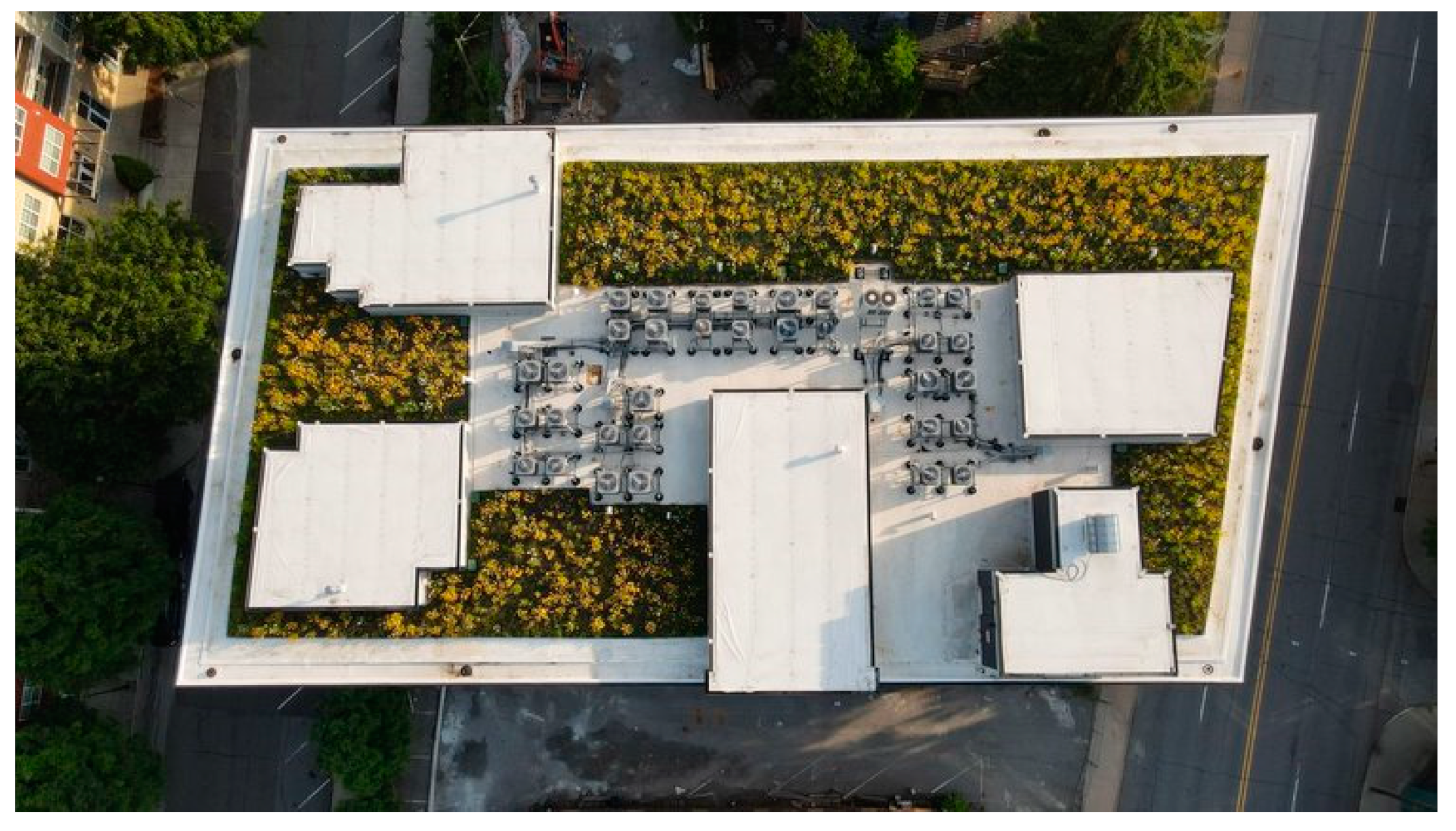
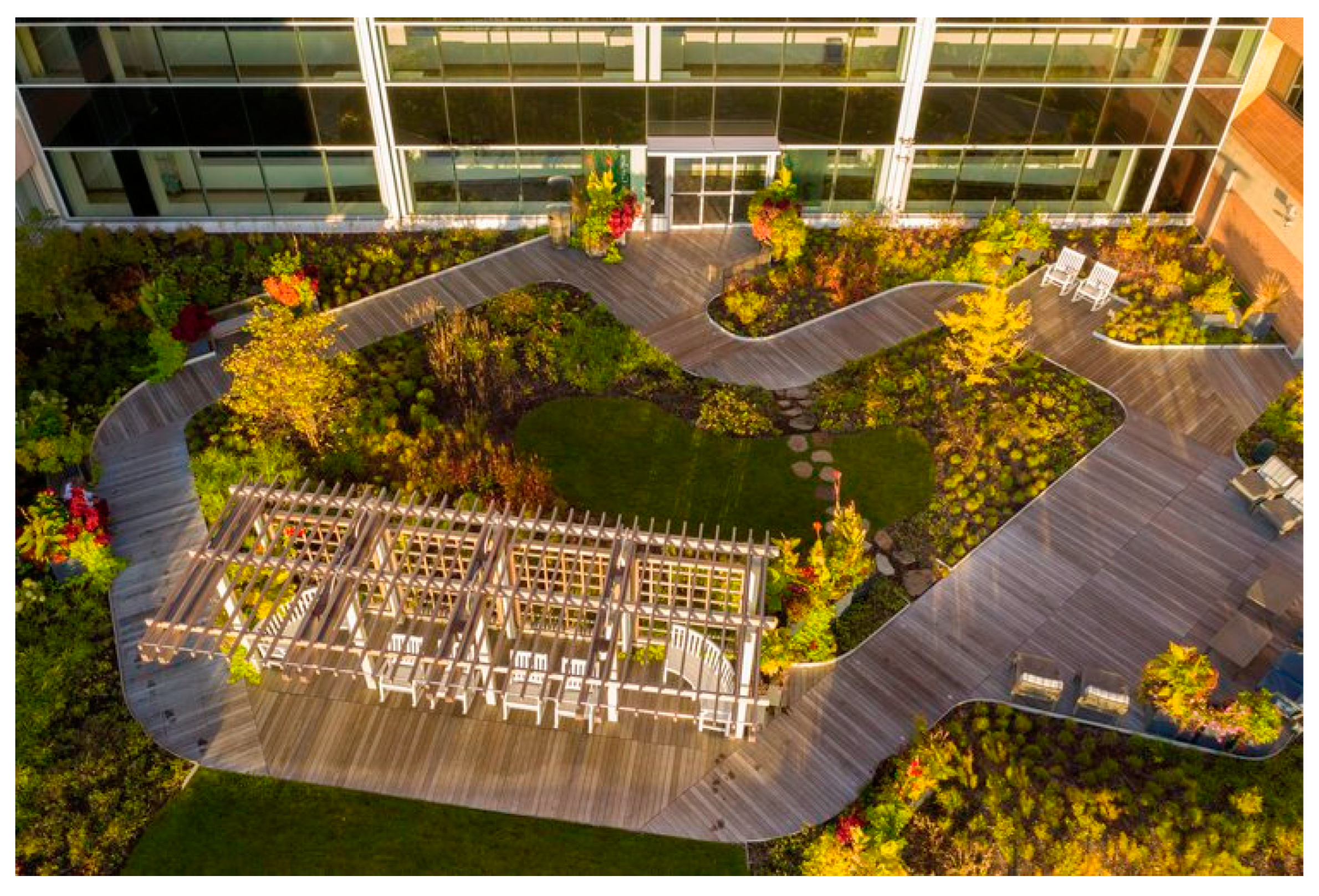
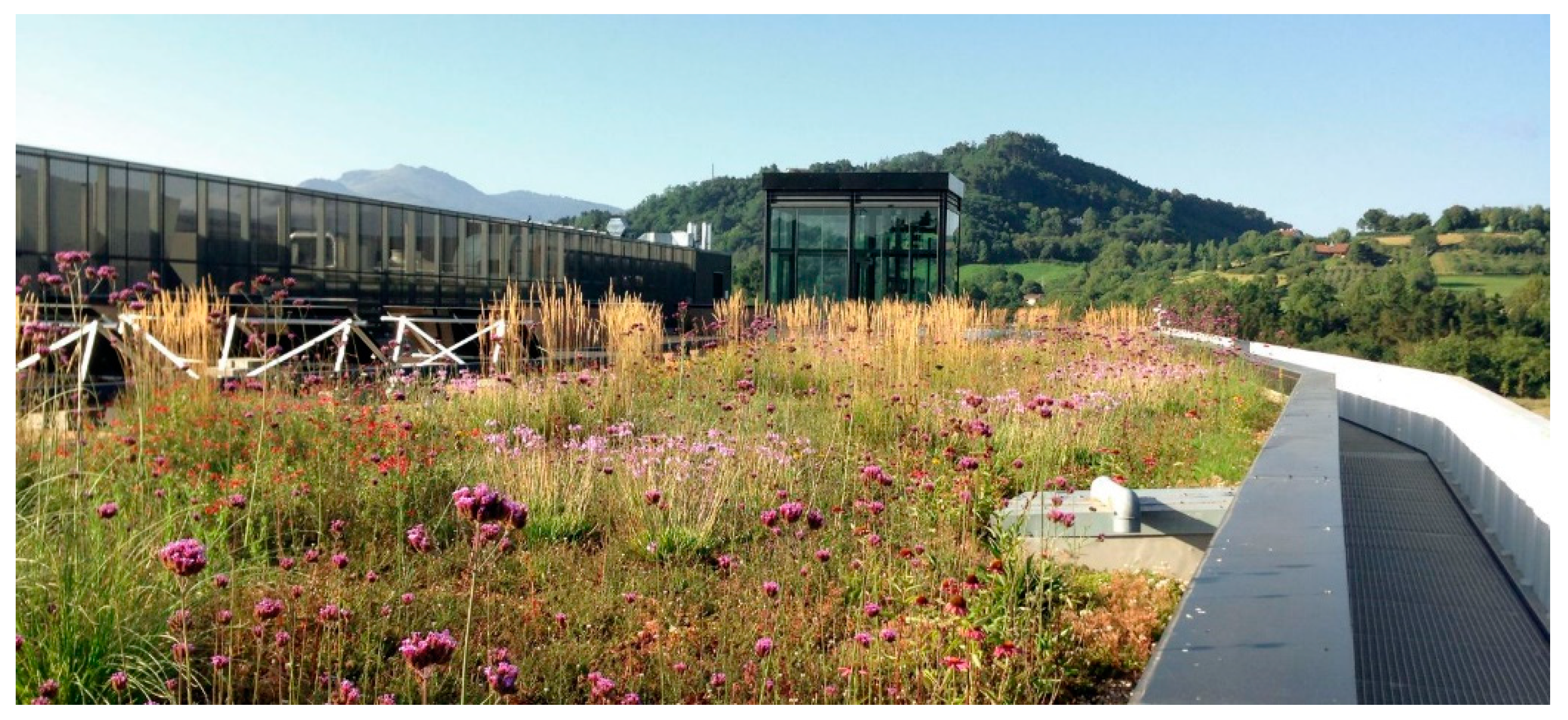
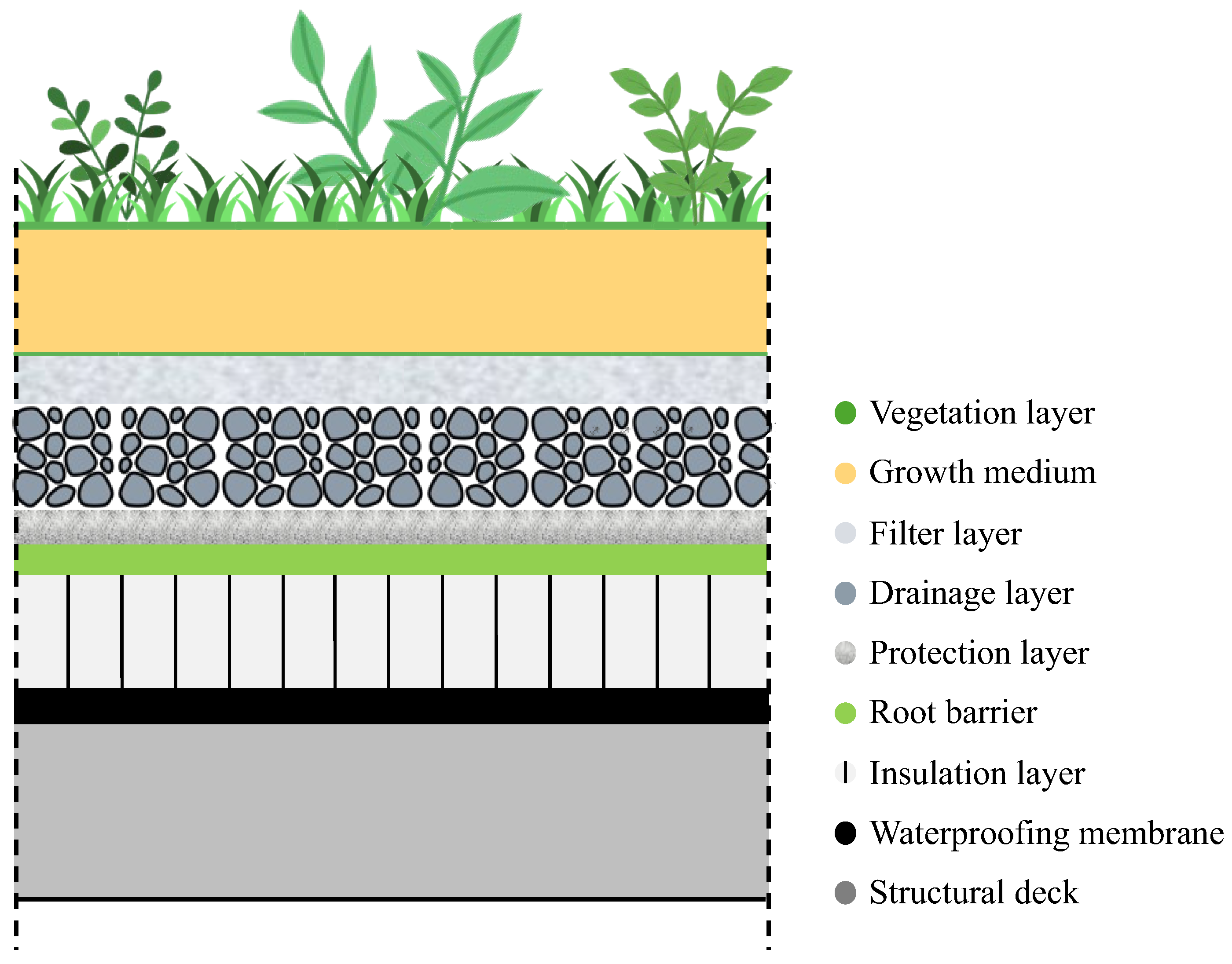
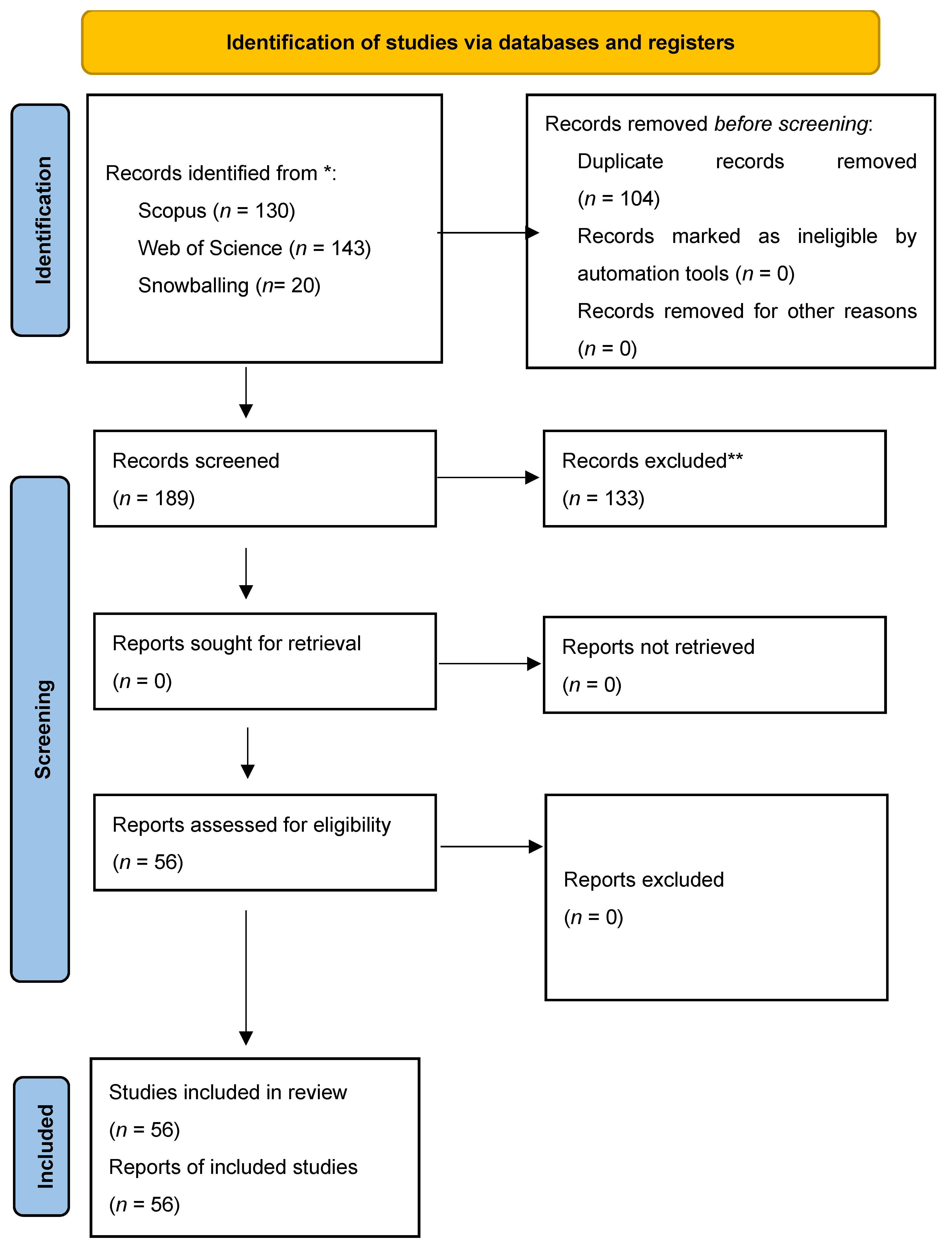
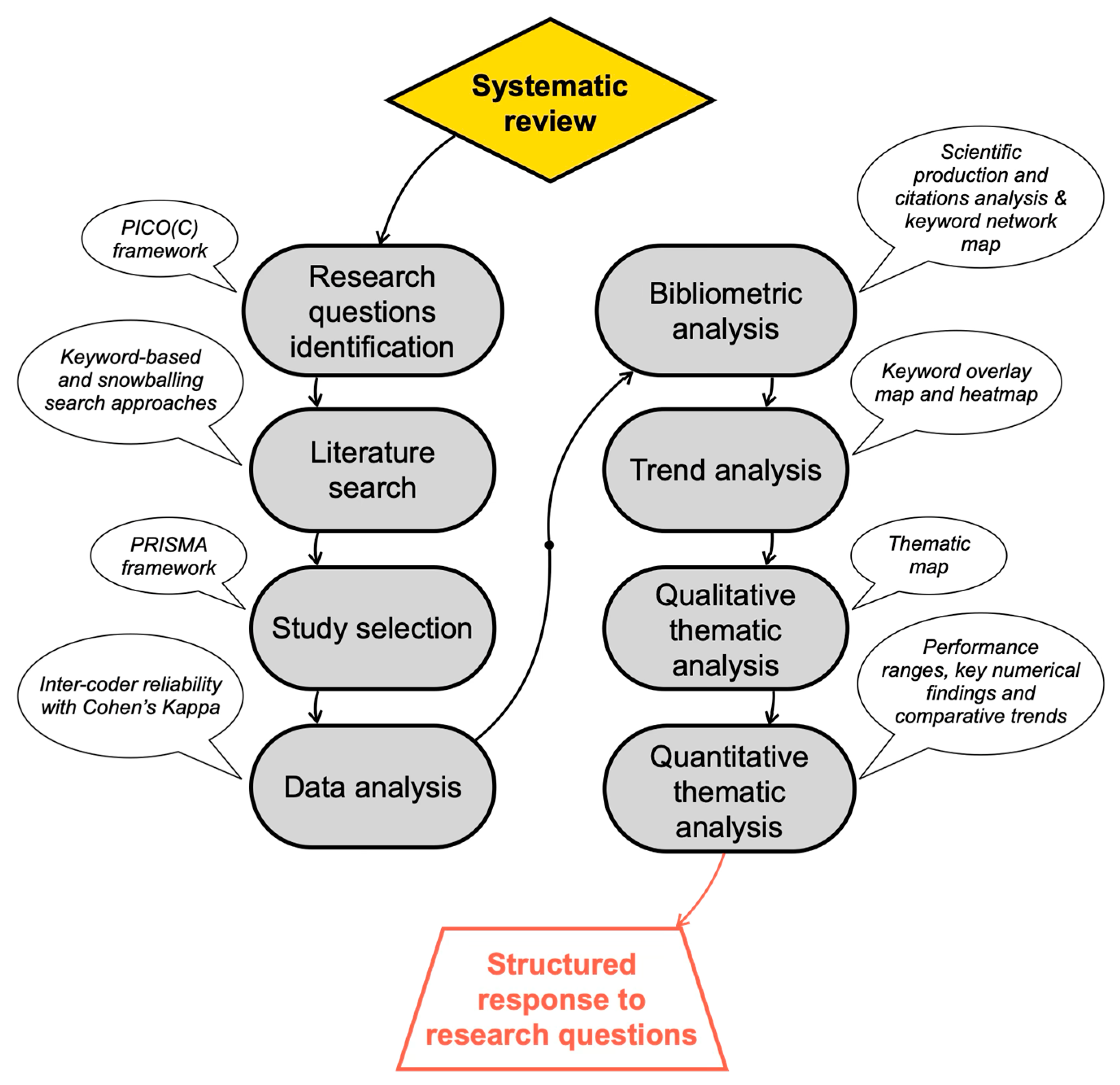
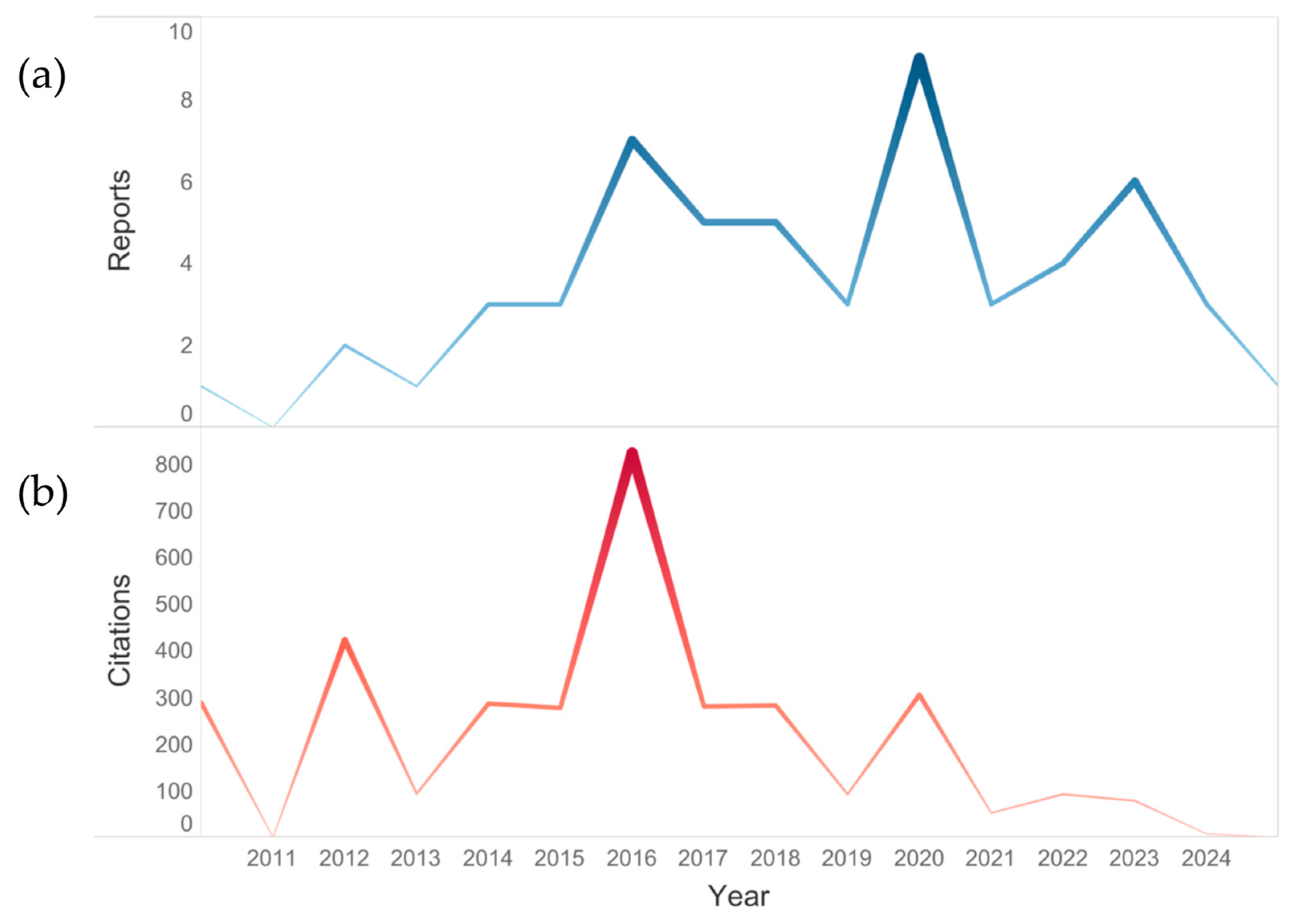
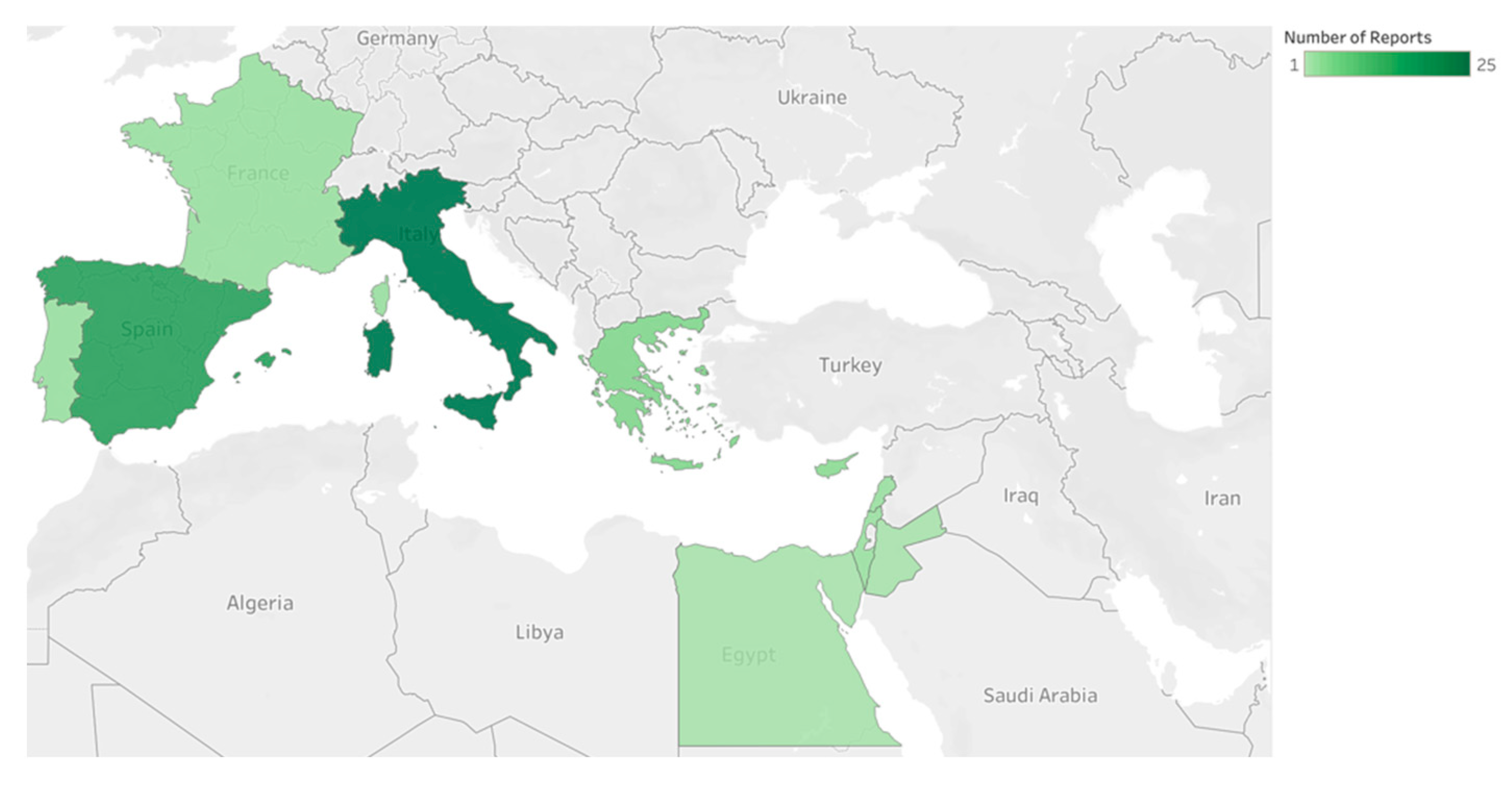
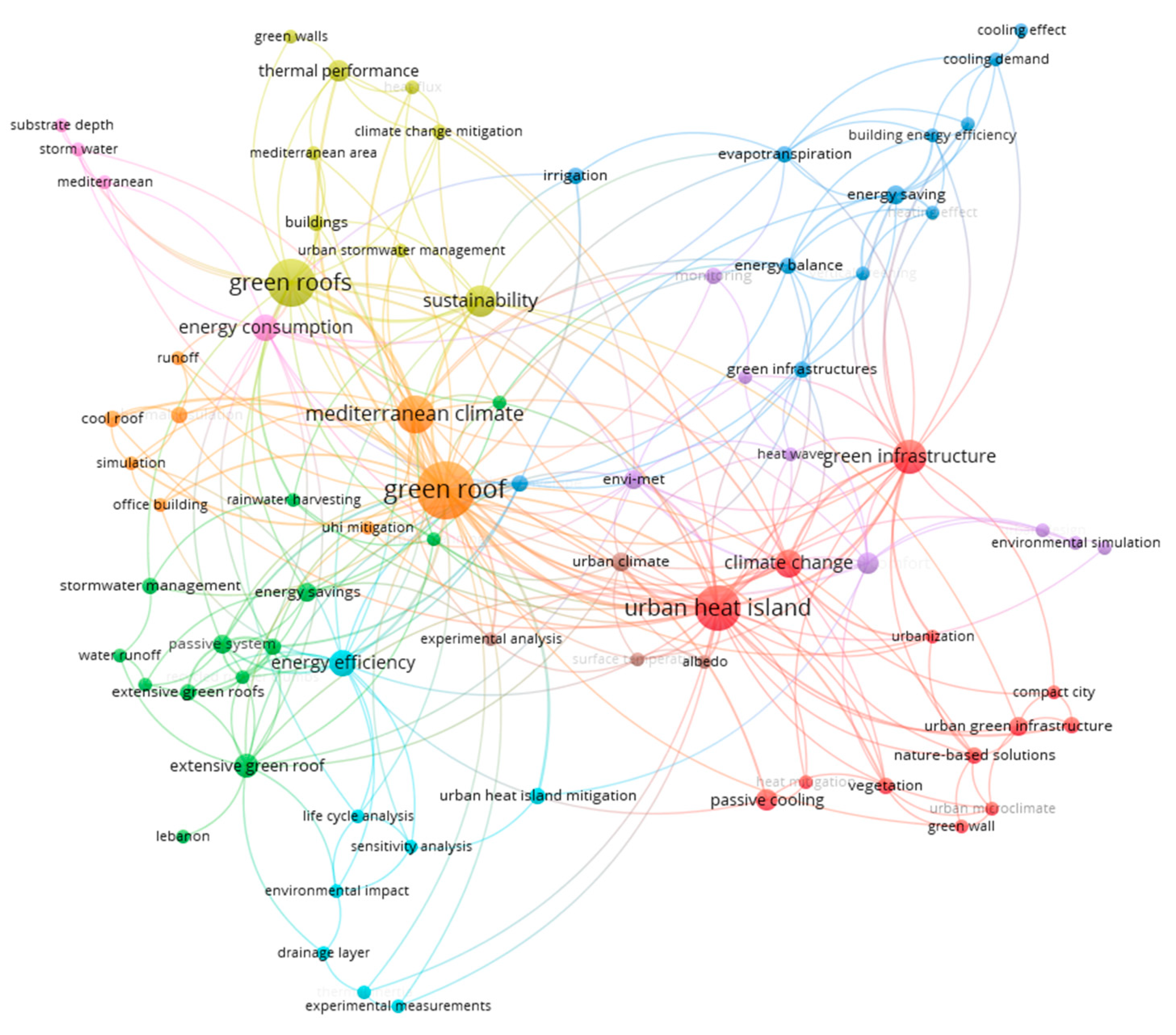
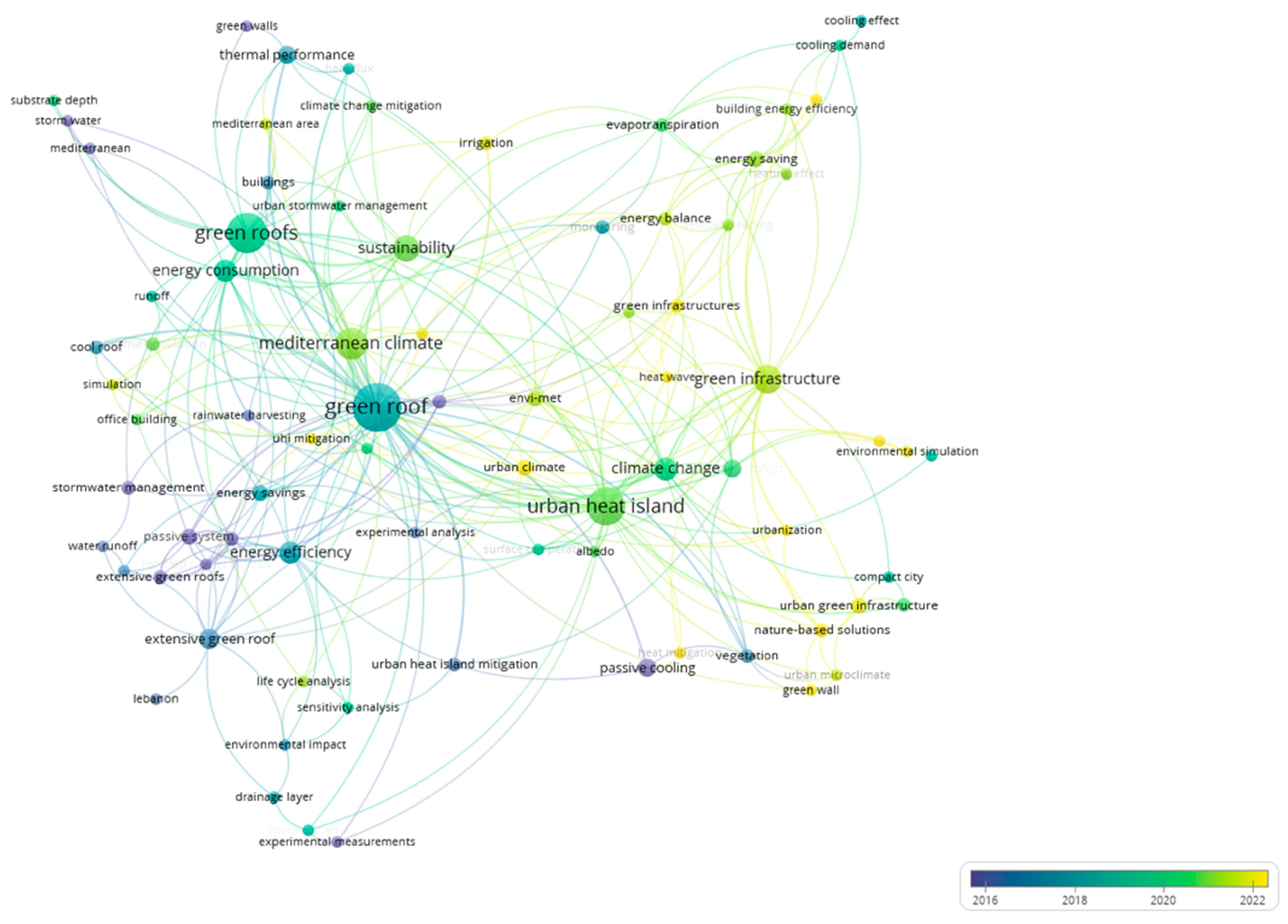

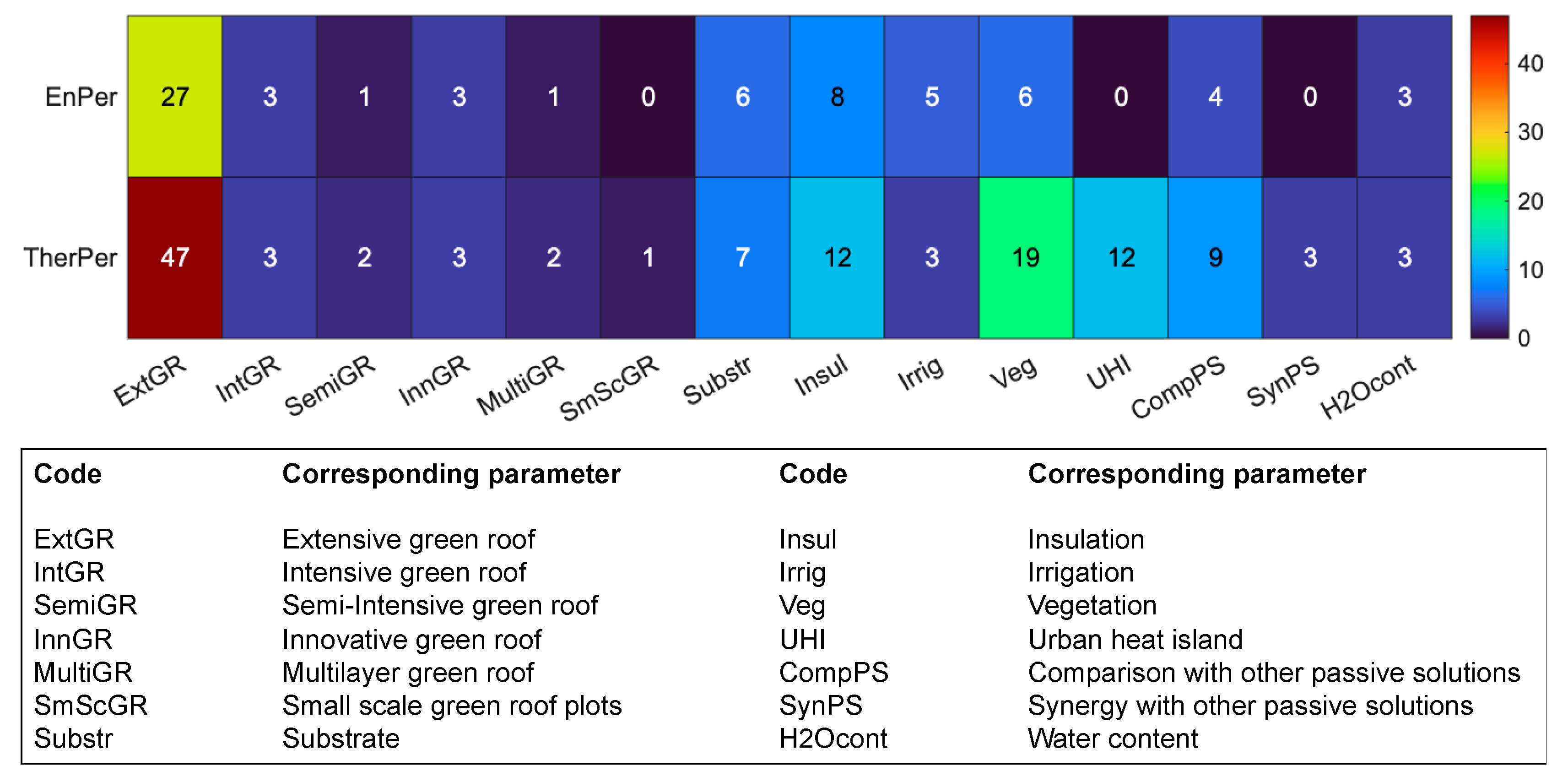
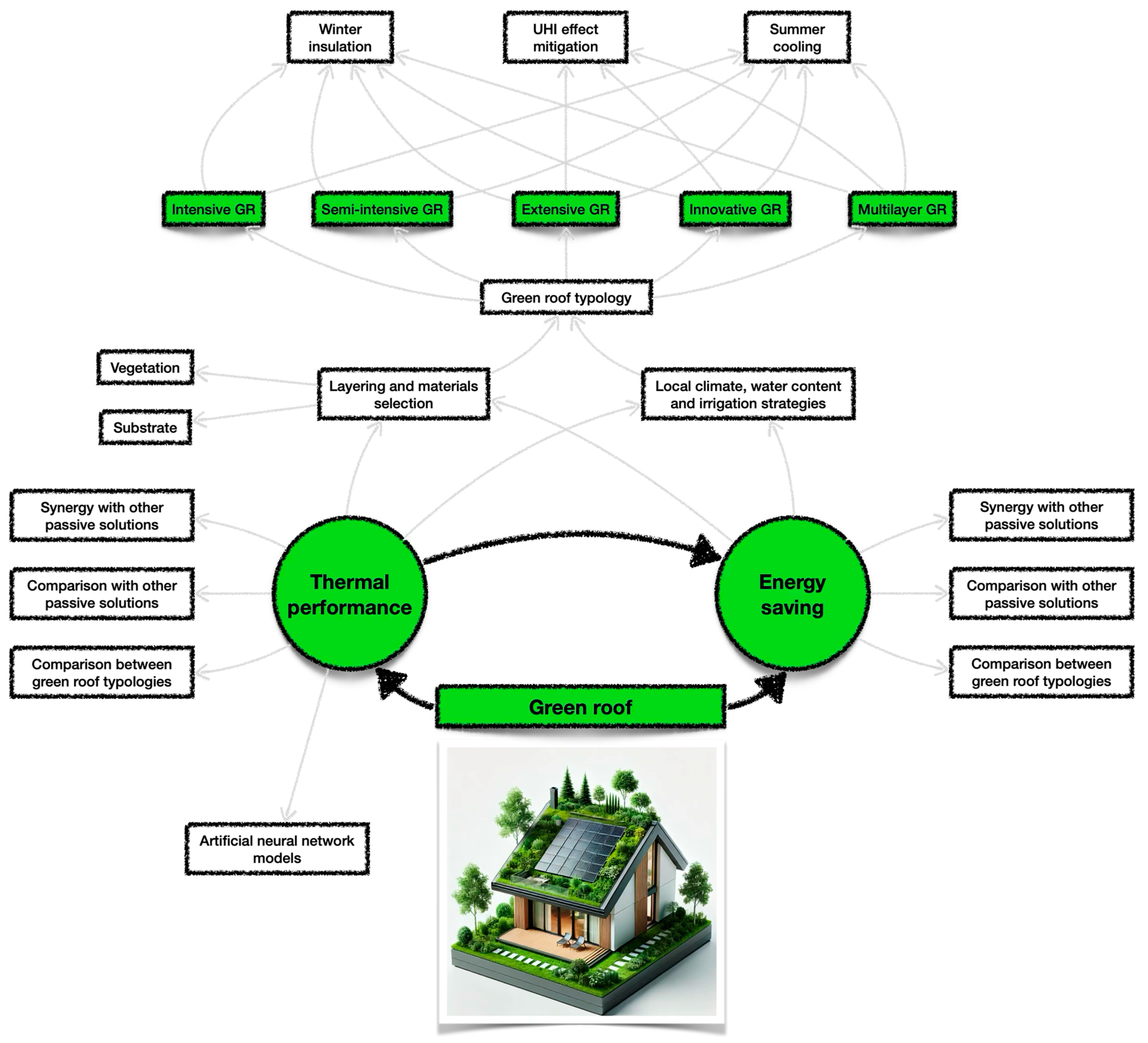
| Layer | Typical Thickness | Typical Materials | Main Function |
|---|---|---|---|
| Plants and vegetation | Varies according to green roof typology | Species adapted to local climate (e.g., Sedum spp., grasses, shrubs, small trees) | Regulating microclimatic conditions through shading and evapotranspiration; enhancing biodiversity; contributing to stormwater management, thermal regulation, and air purification. |
| Growth medium | Up to 150 mm for extensive roofs; up to 600 mm for intensive systems | Blend of inorganic (≈90%) and organic (≈10%) components | Supporting vegetation growth; providing thermal mass; enhancing water retention and thermal inertia. |
| Filter layer | 0.5–2 mm | Geotextile fabrics (polypropylene or polyester) | Maintaining permeability by preventing substrate particle migration; optimizing stormwater management. |
| Drainage layer | 20–100 mm | Granular aggregates or plastic-based drainage panels | Regulating water flow; preventing waterlogging; maintaining an optimal air–water balance within the substrate. |
| Protection layer | 3–10 mm | Geotextile or polyester-based materials | Providing mechanical protection to underlying layers during installation and operational life. |
| Anti-root layer | ~4 mm | Polyethylene sheets, plastic composites | Preventing root intrusion; protecting waterproofing membranes and structural integrity. |
| Insulation layer | 40–100 mm (extensive roofs); 100–200 mm (intensive roofs) | Extruded polystyrene (XPS), expanded polystyrene (EPS), polyurethane foams, polyisocyanurate, cork-based panels, mineral wool | Enhancing building thermal resistance; reducing heating and cooling loads; improving acoustic insulation. |
| Waterproofing membrane | 1.5–4 mm | Synthetic rubber or bituminous membranes | Providing a durable, watertight barrier; resisting mechanical and environmental stresses. |
| Query for Web of Science | Query for Scopus |
|---|---|
| TS = ((“green roof *” OR “vegetated roof *” OR “green infrastructure” OR “living roof *” OR “extensive green roof *” OR “intensive green roof *” OR “semi-intensive green roof *”) AND (“thermal insulation” OR “thermal properties” OR “cooling potential” OR “heat transfer” OR “building energy efficiency” OR “energy efficiency” OR “energy demand” OR “energy saving *” OR “thermal inertia” OR “thermal comfort” OR “thermal performance” OR “passive cooling” OR “water efficiency” OR “building energy” OR “cooling capacity” OR “stormwater management” OR “runoff retention” OR “urban heat island” OR “urban heat island mitigation” OR “climate adaptation” OR “climate resilience” OR “urban resilience” OR “sustainable urban design” OR “seasonal variability” OR “passive system” OR “reduce energy demand” OR “reduce energy needs”) AND (“Mediterranean” OR “Mediterranean climate” OR “Mediterranean basin” OR “Mediterranean region” OR “Mediterranean cities” OR “hot-dry climate” OR “hot summer climate” OR “warm temperate climate”)) | TITLE-ABS-KEY((“green roof *” OR “vegetated roof *” OR “green infrastructure” OR “living roof *” OR “extensive green roof *” OR “intensive green roof *” OR “semi-intensive green roof *”) AND (“thermal insulation” OR “thermal properties” OR “cooling potential” OR “heat transfer” OR “building energy efficiency” OR “energy efficiency” OR “energy demand” OR “energy saving *” OR “thermal inertia” OR “thermal comfort” OR “thermal performance” OR “passive cooling” OR “water efficiency” OR “building energy” OR “cooling capacity” OR “stormwater management” OR “runoff retention” OR “urban heat island” OR “urban heat island mitigation” OR “climate adaptation” OR “climate resilience” OR “urban resilience” OR “sustainable urban design” OR “seasonal variability” OR “passive system” OR “reduce energy demand” OR “reduce energy needs”) AND (“Mediterranean” OR “Mediterranean climate” OR “Mediterranean basin” OR “Mediterranean region” OR “Mediterranean cities” OR “hot-dry climate” OR “hot summer climate” OR “warm temperate climate”)) |
| Criteria | Inclusion | Exclusion |
|---|---|---|
| Study Type | Peer-reviewed research articles | Review articles, conference papers, data articles, editorial letters, book chapters, patents, white papers, non-peer-reviewed reports |
| Study Scope | Research specifically focusing on green roof technologies, and their thermal and energy-related benefits | Studies focusing on green façades, vertical gardens, or other green infrastructure without addressing green roofs |
| Climatic Relevance | Studies conducted in Mediterranean climates | Studies in cold or tropical climates unless they provide comparative insights relevant to Mediterranean conditions |
| Methodological Rigor | Studies with clear methodology, experimental tests, numerical simulations, or validated models. | Studies lacking clear methodology, poorly documented results, or without quantifiable performance indicators |
| PICO(C) | Definition | Application to the Study Objective |
|---|---|---|
| P (Population) | Peer-reviewed papers on green roof technology | Analysis of peer-reviewed research articles addressing the implementation of green roofs on residential, commercial, and public buildings in Mediterranean climates |
| I (Intervention) | Systematic literature review | Analysis of the thermal and energy benefits of green roofs, their limitations, and design strategies |
| C (Comparison) | Comparison between green roofs and other passive technologies | Comparative analysis of green roofs versus:
|
| O (Outcome) |
| Identification of key aspects regarding the thermal and energy performance of green roofs. Assessment of design challenges, research gaps, and areas requiring further investigation. Examination of the main performance metrics used across studies |
| C (Context) | Green roofs in Mediterranean regions | Focus on green roof implementation in Mediterranean areas, characterized by hot, dry summers and mild, wet winters |
| EnPer | TherPer | |
|---|---|---|
| ExtGR | [84,86,88,90,92,93,95,96,97,99,100,106,110,112,114,117,118,119,121,123,125,126,129,130,131,132,145] | [84,85,86,87,88,89,92,93,95,96,97,98,99,100,101,102,103,105,106,107,108,109,110,113,114,115,116,117,119,120,121,123,125,126,127,128,129,130,131,132,134,135,136,137,138,139,145] |
| IntGR | [100,104,114] | [100,104,114] |
| SemiGR | [114] | [114,137] |
| InnGR | [91,94,133] | [91,94,133] |
| MultiGR | [124] | [111,124] |
| SmScGR | [134] | |
| Substr | [84,92,93,100,112,131] | [92,93,105,110,121,131,135] |
| Insul | [86,88,91,97,112,118,123,129] | [85,86,87,89,91,97,103,107,109,123,129,137] |
| Irrig | [88,90,95,100,119] | [85,103,116] |
| Veg | [88,93,96,100,118,145] | [85,87,93,96,102,104,106,107,109,113,116,120,121,127,134,135,136,139,145] |
| UHI | [92,101,102,103,104,111,119,120,133,135,137,138] | |
| CompPS | [97,99,114,145] | [97,99,101,102,108,114,115,138,145] |
| SynPS | [101,115,120] | |
| H2Ocont | [95,99,131] | [85,131,135] |
| Theme | Description |
|---|---|
| Layering and materials selection | The selection of geometry, materials, and vegetation for each layer is crucial in defining the thermal and energy performance of green roofs. In particular, the design of the substrate and vegetation layer plays a key role in indoor comfort regulation, UHI mitigation, and seasonal thermal efficiency. The inclusion of additional insulating layers significantly deteriorates green roof performance. |
| Local Climate | The type of green roof and the technical characteristics of each layer must be carefully designed in response to local meteorological conditions to ensure optimal performance and durability. |
| Irrigation Strategies | Implementing effective irrigation strategies is essential for optimizing the thermal and energy performance of green roofs. Water content regulation within the substrate regulates insulation in winter and cooling efficiency in summer. Irrigation during winter reduces insulation effectiveness, while in summer, it is fundamental for cooling performance. |
| Synergy with Other Passive Solutions | Combining green roof technology with other passive strategies can significantly enhance a building’s thermal and energy performance, leading to greater efficiency in heat regulation and overall sustainability. |
| Comparison with Other Passive Solutions | Green roofs generally exhibit lower cooling effects compared to living walls and green façades. However, they outperform cool roofs in terms of energy efficiency. Advanced and innovative green roof designs can achieve superior thermal and energy performance compared to conventional green roof systems. |
| Advanced models | Artificial neural network models provide reliable prediction for Mediterranean green roofs |
| Aspect Analyzed | Key Findings | References |
|---|---|---|
| Ambient temperature reduction | 0.03–7.4 °C | [102,105] |
| Annual energy savings | 10–34.7% | [86,123] |
| Cooling energy demand reduction | 2.2–100% | [88,93] |
| Heating energy efficiency increase | 6.3–66% | [86,110] |
| Indoor temperature reduction | 0.2–2.3 °C | [84,88] |
| Peak indoor surface temperature decrease | Up to 12.1 °C | [139] |
| Daily thermal fluctuation reduction | From 68% | [89] |
| UHI mitigation effect (summer) | Up to 7.4 °C | [105] |
| UHI mitigation effect (winter) | Up to 5.7 °C | [105] |
| External surface temperature reduction | Up to 86% | [111] |
| PV efficiency improvement (with green roof) | Up to 3.33% | [141] |
| Irrigation-based cooling efficiency increase | Up to 500% | [100] |
| Innovative green roof external surface temperature reduction | Up to 25 °C | [123] |
| Innovative green roof indoor temperature reduction | Up to 2 °C | [91] |
| Innovative green roof heating performance increase | Up to 31% | [94] |
| Innovative green roof cooling performance increase | Up to 50% | [94] |
| Multilayer green roof external surface temperature reduction | Up to 40% | [124] |
| Multilayer green roof indoor temperature reduction | Up to 3.7 °C | [124] |
| Comparison | Key Findings |
|---|---|
| Green Roof vs. Cool Roof [97,101,108,117,123,128] | Cool roofs provide superior UHI mitigation. However, irrigated green roofs outperform cool roofs in overall energy savings, achieving +10% higher efficiency. |
| Green Roof vs. Living Wall [102,138] | Living walls demonstrate greater effectiveness in UHI mitigation, particularly at pedestrian level, by ensuring better microclimate regulation. |
| Green Roof vs. Green Façade [102,108,115,138] | Green facades outperform green roofs in UHI mitigation, achieving 1.2 °C higher ambient temperature reduction. |
| Green Roof vs. High-Albedo Pavement [104,108] | High-albedo pavements provide the best UHI mitigation effect among passive strategies, due to their high solar reflectance. |
| Green Roof vs. Wetted Roof [103] | Wetted roofs show superior UHI mitigation compared to green roofs, particularly in extreme heat conditions. |
| Green Roof vs. Rooftop Greenhouses [99] | Rooftop greenhouses achieve 43% greater cooling energy savings than green roofs, making them a more effective solution for cooling demand reduction. |
| Study Location | References |
|---|---|
| Cyprus | [118,119,139] |
| Egypt | [117] |
| France | [103,137] |
| Greece | [104,115,125,136] |
| Israel | [113] |
| Italy | [86,88,89,91,92,94,95,96,97,99,102,106,109,111,117,121,123,124,126,128,129,132,133,138] |
| Jordan | [84] |
| Lebanon | [105,135] |
| Portugal | [100,114] |
| Spain | [81,83,86,89,97,103,104,106,108,112,113,116,123,126,127,141] |
Disclaimer/Publisher’s Note: The statements, opinions and data contained in all publications are solely those of the individual author(s) and contributor(s) and not of MDPI and/or the editor(s). MDPI and/or the editor(s) disclaim responsibility for any injury to people or property resulting from any ideas, methods, instructions or products referred to in the content. |
© 2025 by the authors. Licensee MDPI, Basel, Switzerland. This article is an open access article distributed under the terms and conditions of the Creative Commons Attribution (CC BY) license (https://creativecommons.org/licenses/by/4.0/).
Share and Cite
De Cristo, E.; Evangelisti, L.; Barbaro, L.; De Lieto Vollaro, R.; Asdrubali, F. A Systematic Review of Green Roofs’ Thermal and Energy Performance in the Mediterranean Region. Energies 2025, 18, 2517. https://doi.org/10.3390/en18102517
De Cristo E, Evangelisti L, Barbaro L, De Lieto Vollaro R, Asdrubali F. A Systematic Review of Green Roofs’ Thermal and Energy Performance in the Mediterranean Region. Energies. 2025; 18(10):2517. https://doi.org/10.3390/en18102517
Chicago/Turabian StyleDe Cristo, Edoardo, Luca Evangelisti, Leone Barbaro, Roberto De Lieto Vollaro, and Francesco Asdrubali. 2025. "A Systematic Review of Green Roofs’ Thermal and Energy Performance in the Mediterranean Region" Energies 18, no. 10: 2517. https://doi.org/10.3390/en18102517
APA StyleDe Cristo, E., Evangelisti, L., Barbaro, L., De Lieto Vollaro, R., & Asdrubali, F. (2025). A Systematic Review of Green Roofs’ Thermal and Energy Performance in the Mediterranean Region. Energies, 18(10), 2517. https://doi.org/10.3390/en18102517










